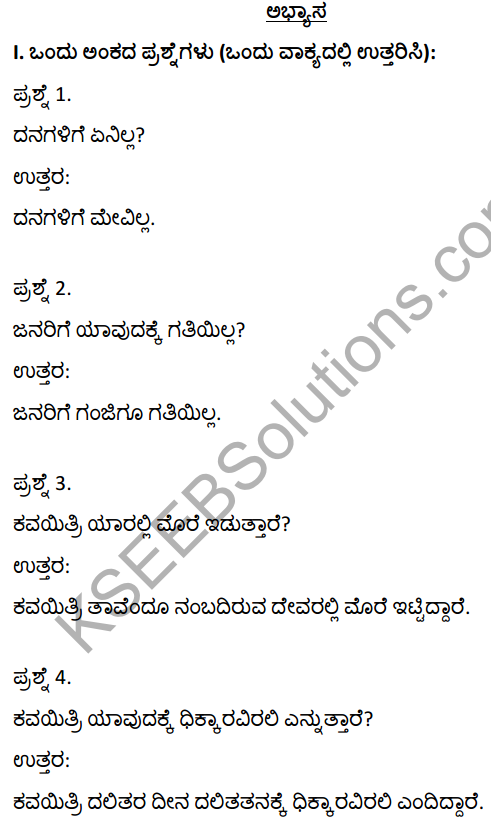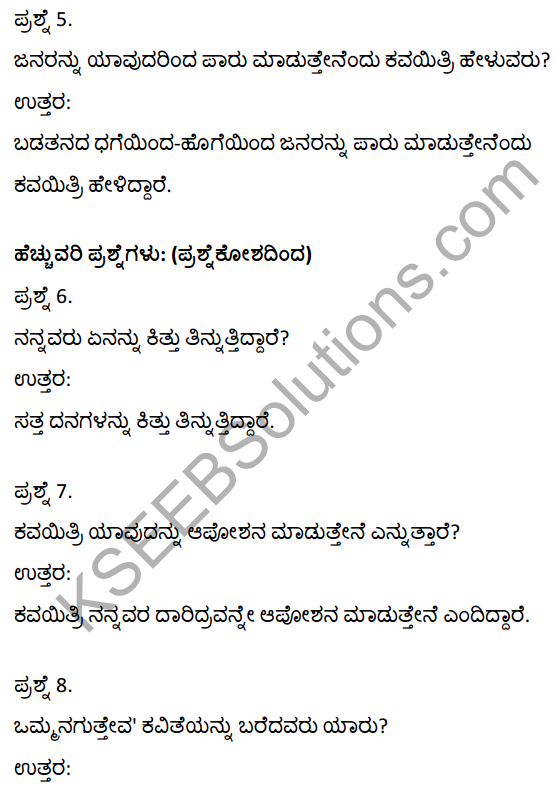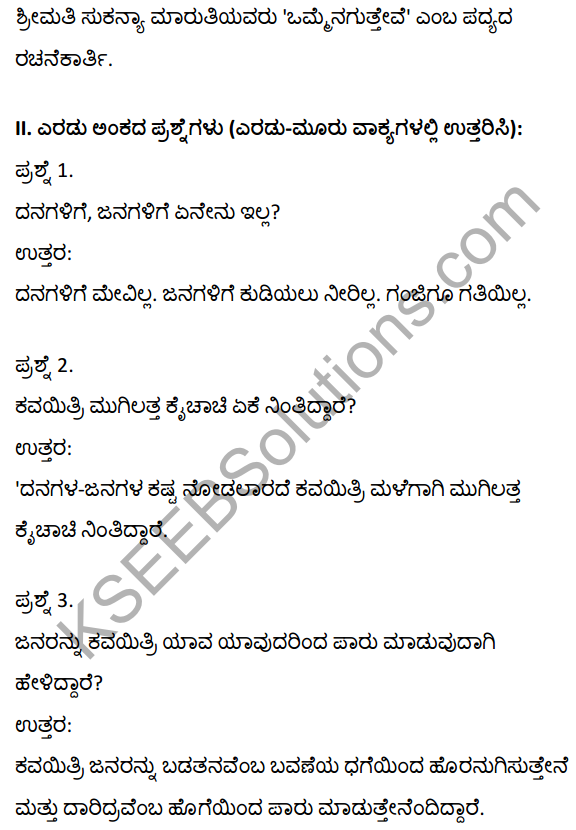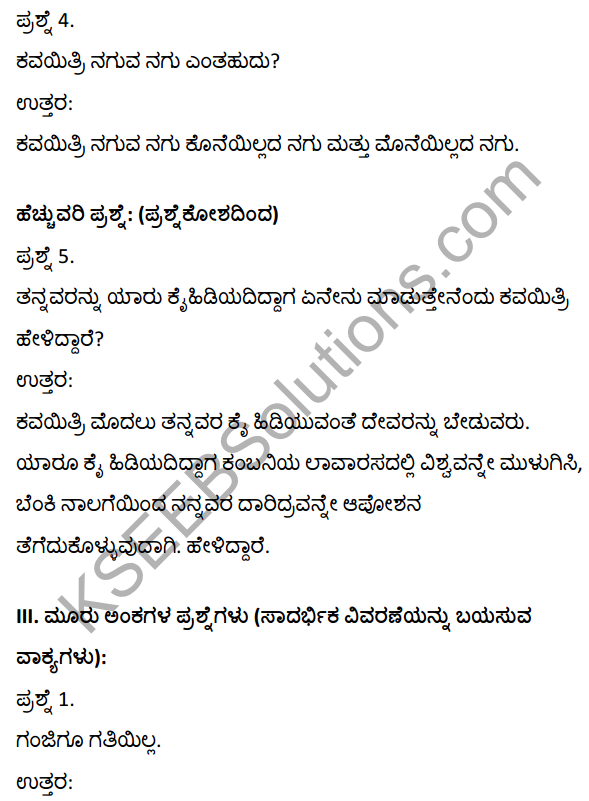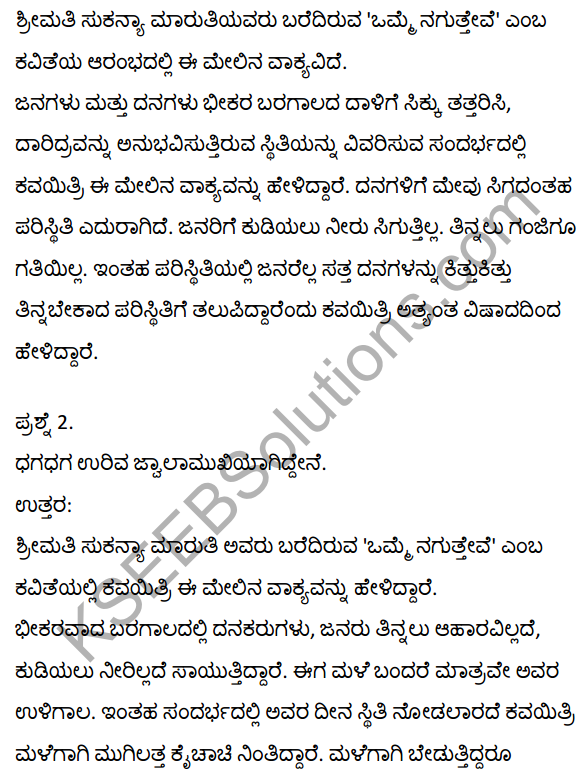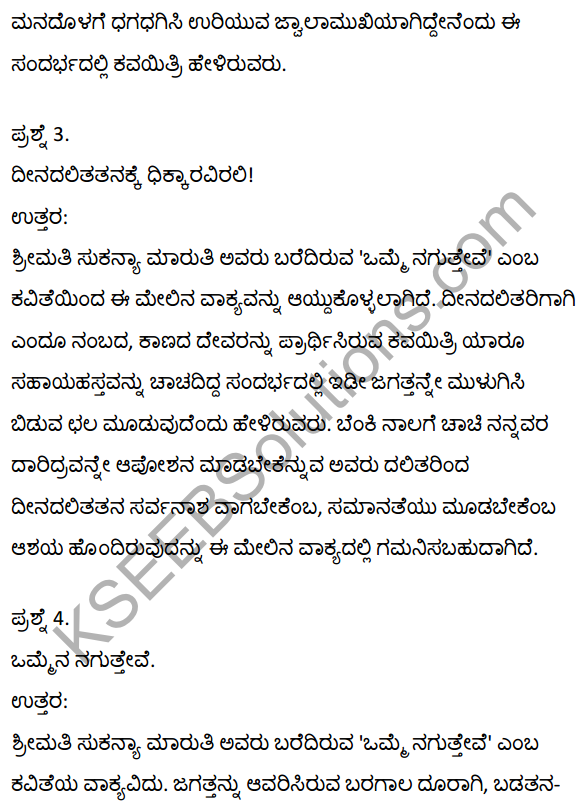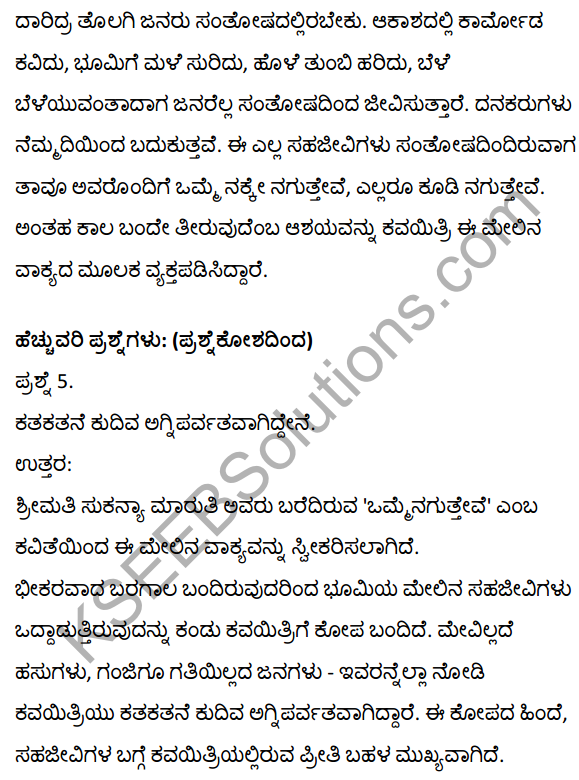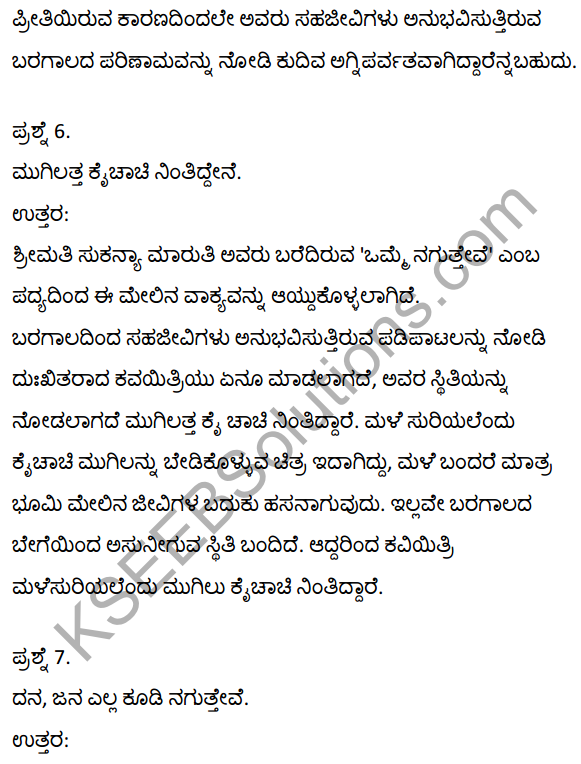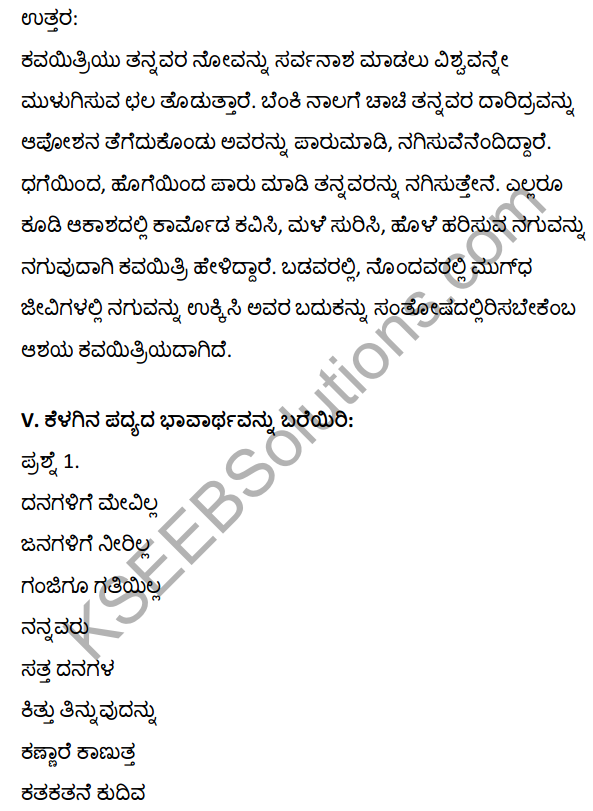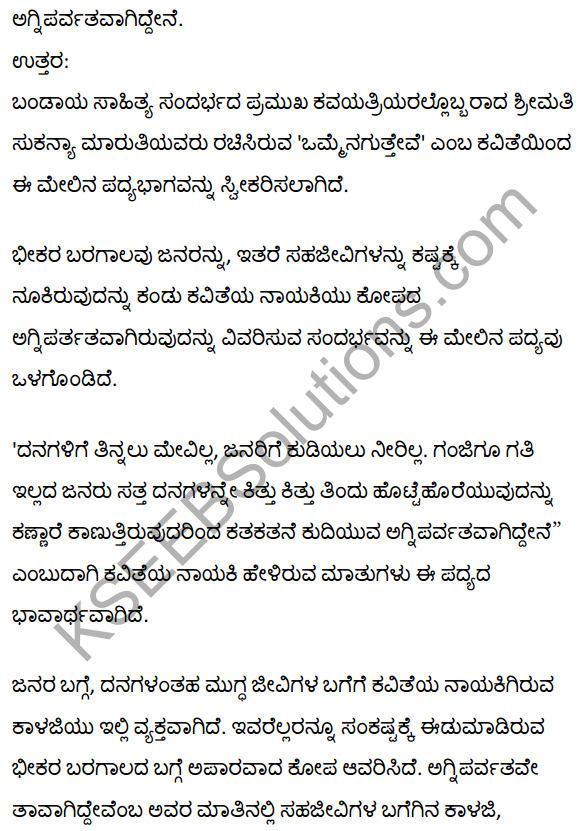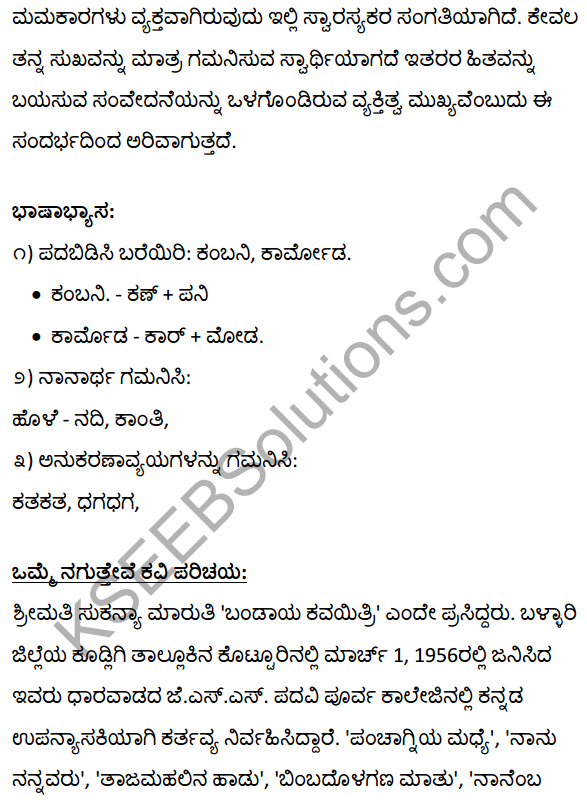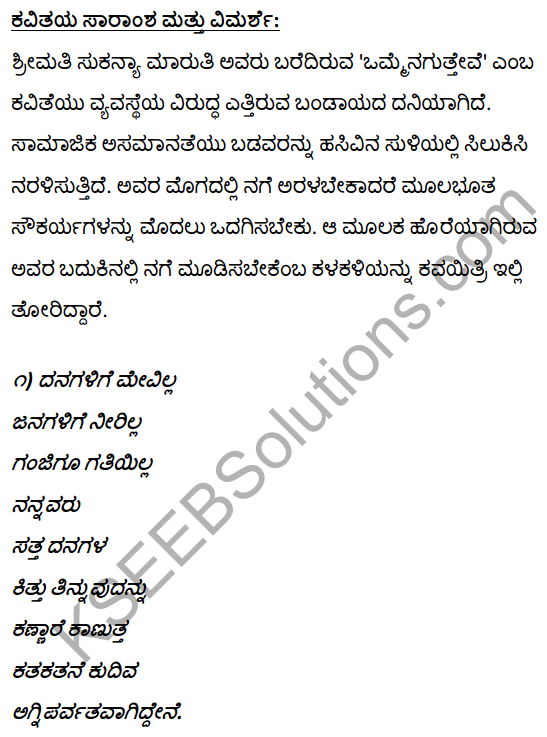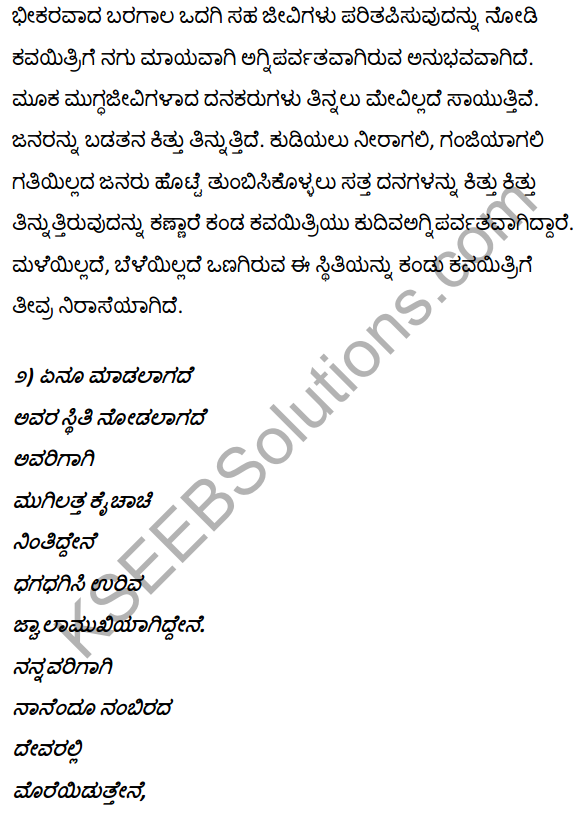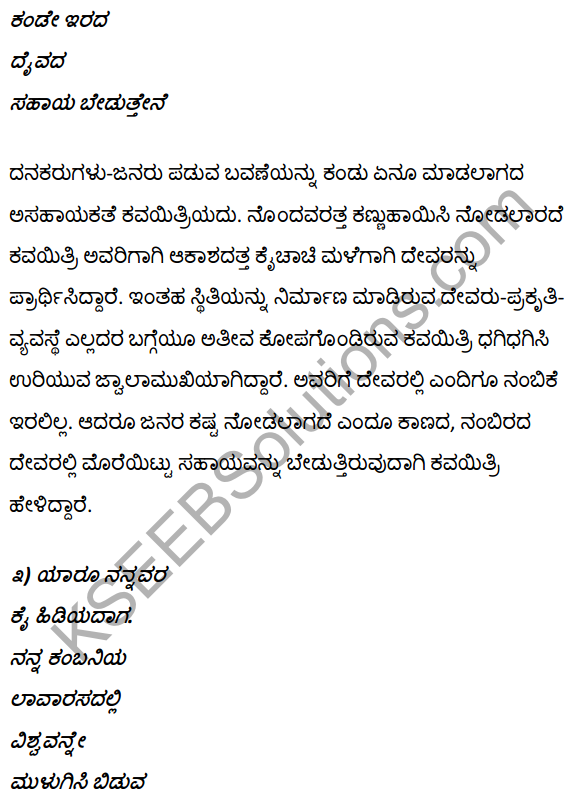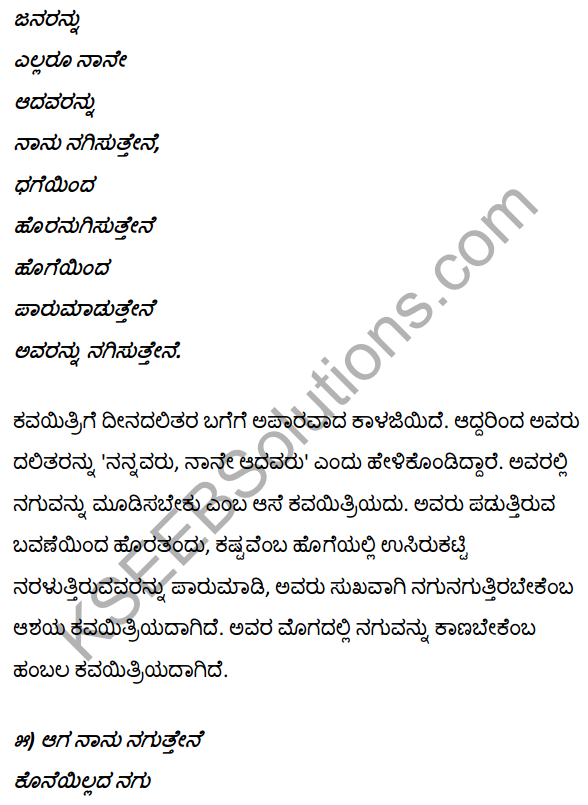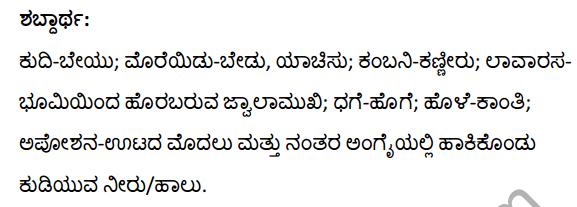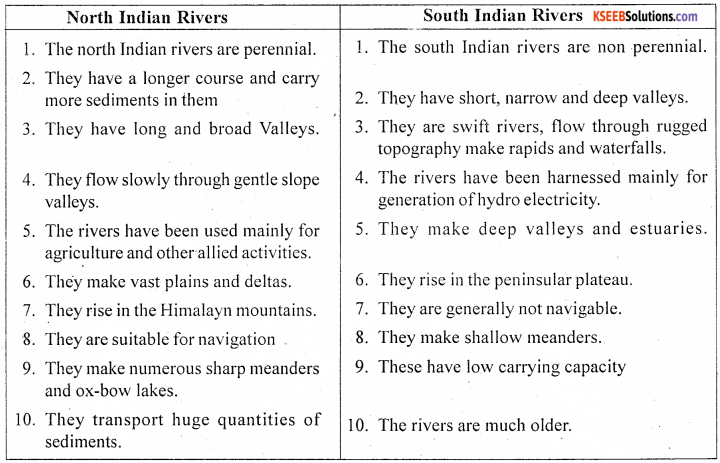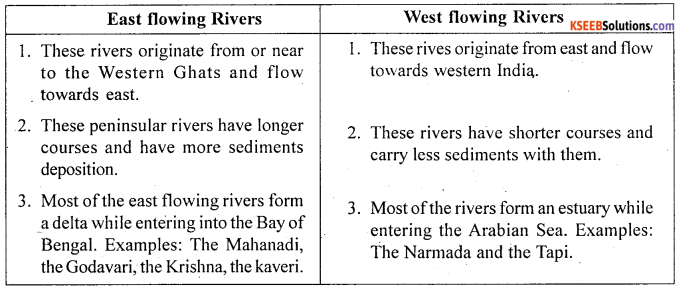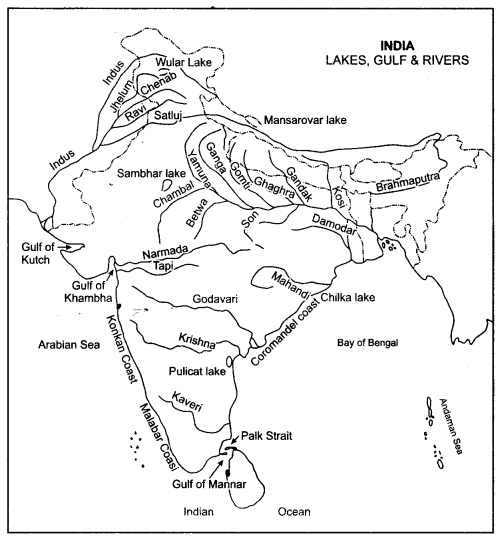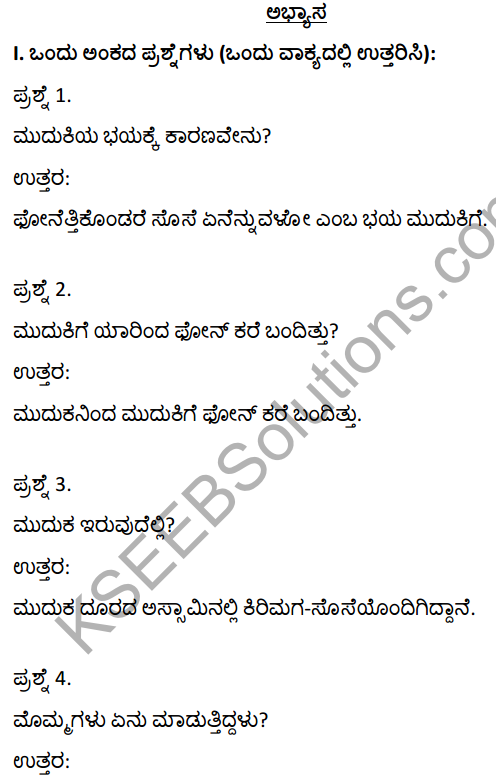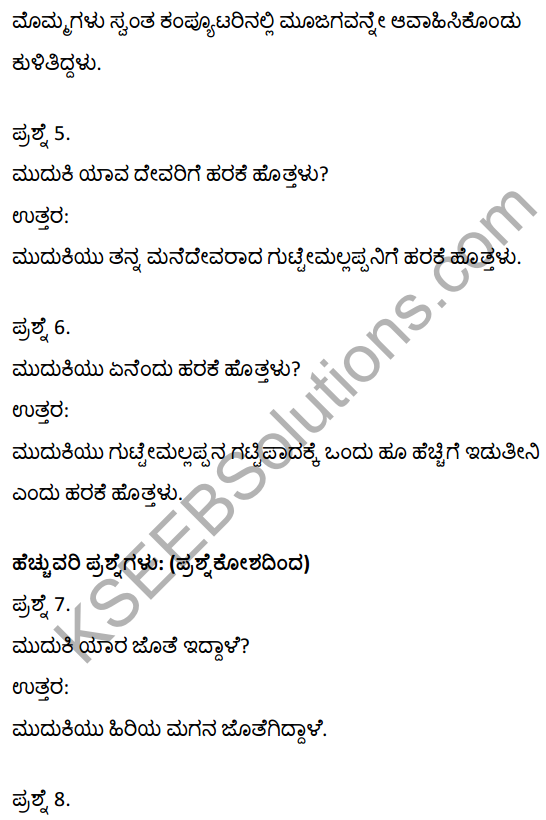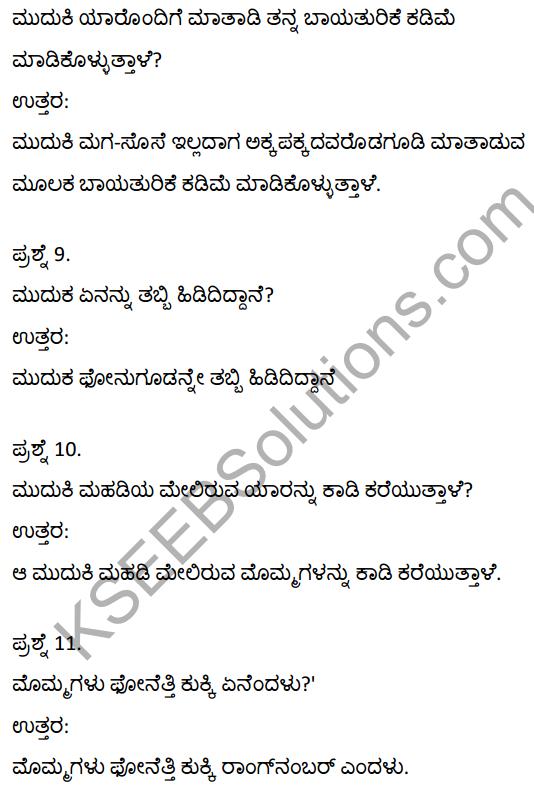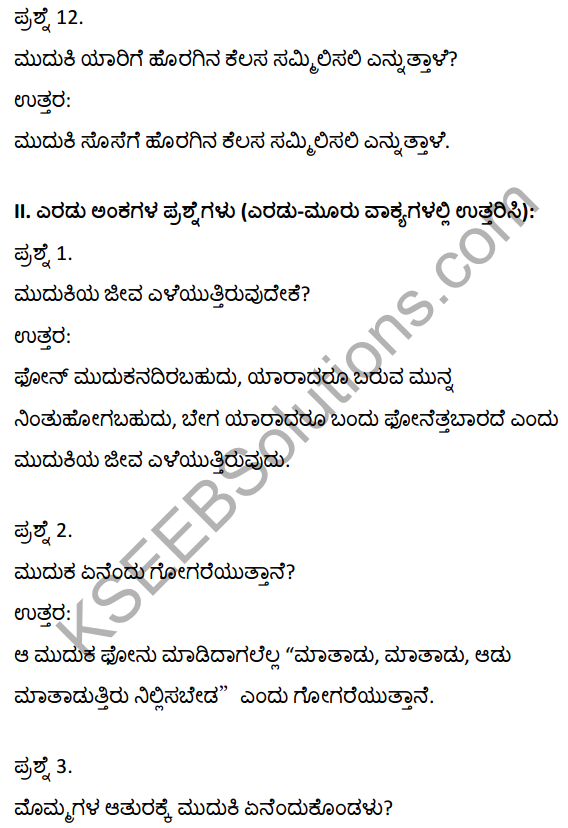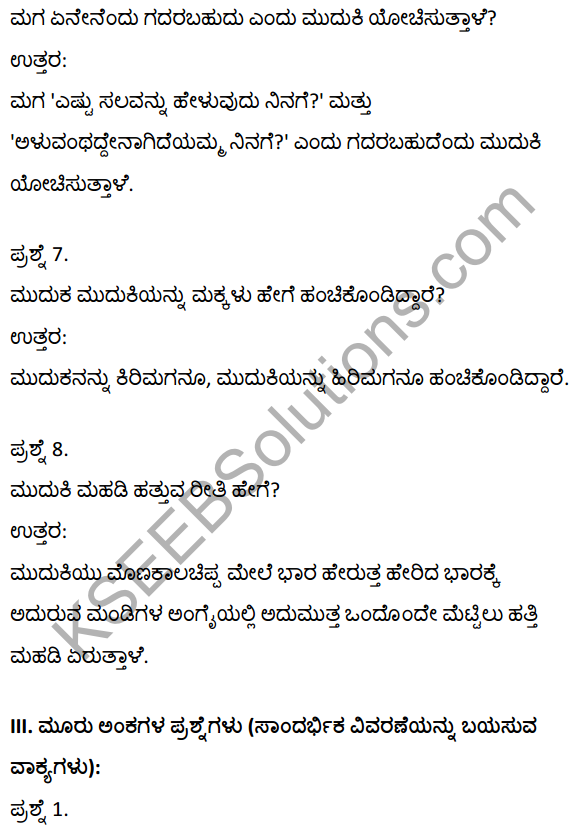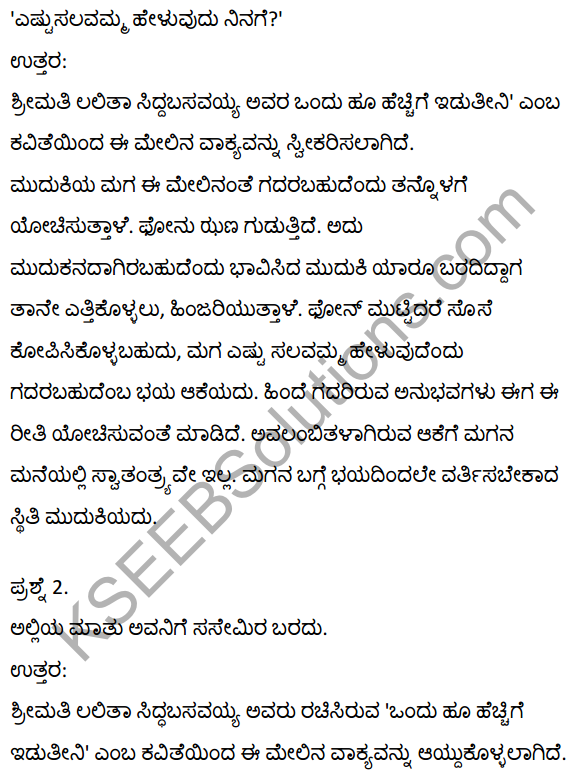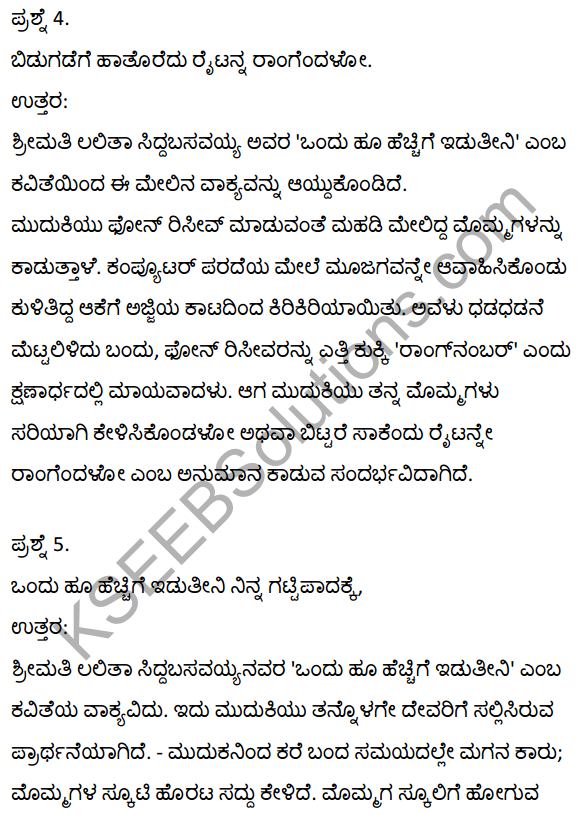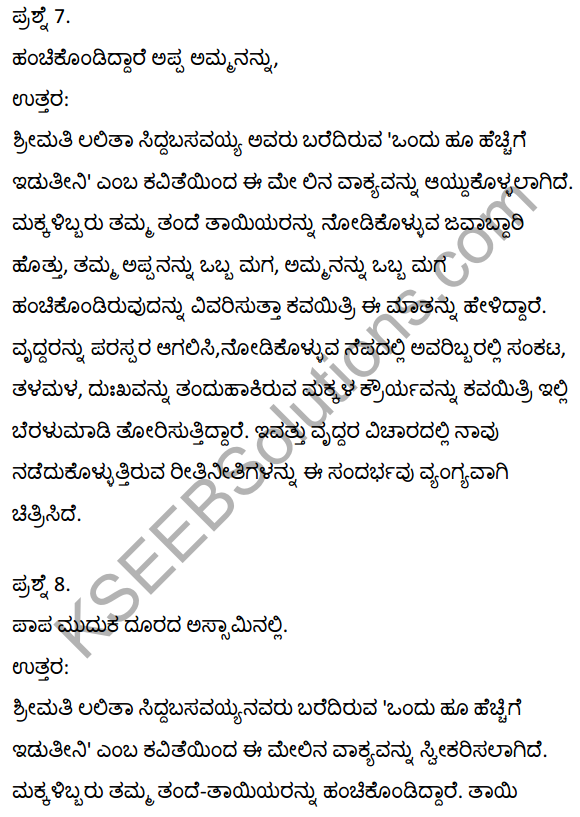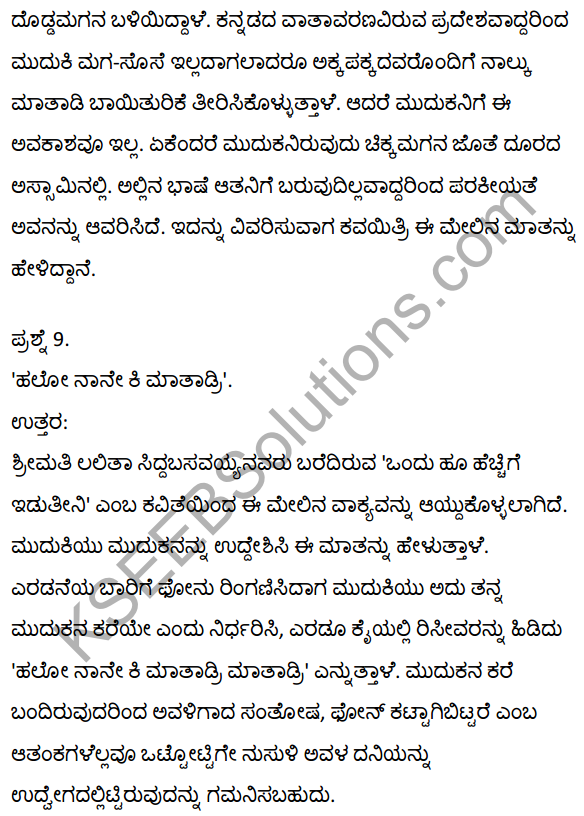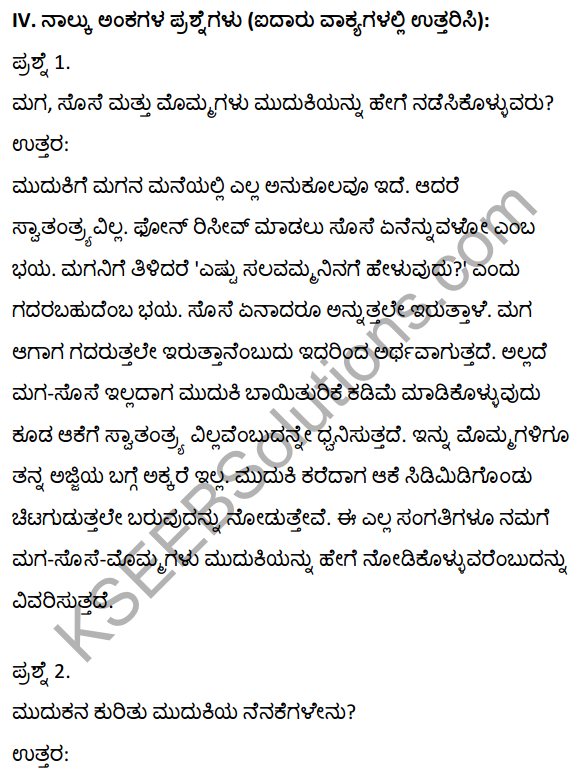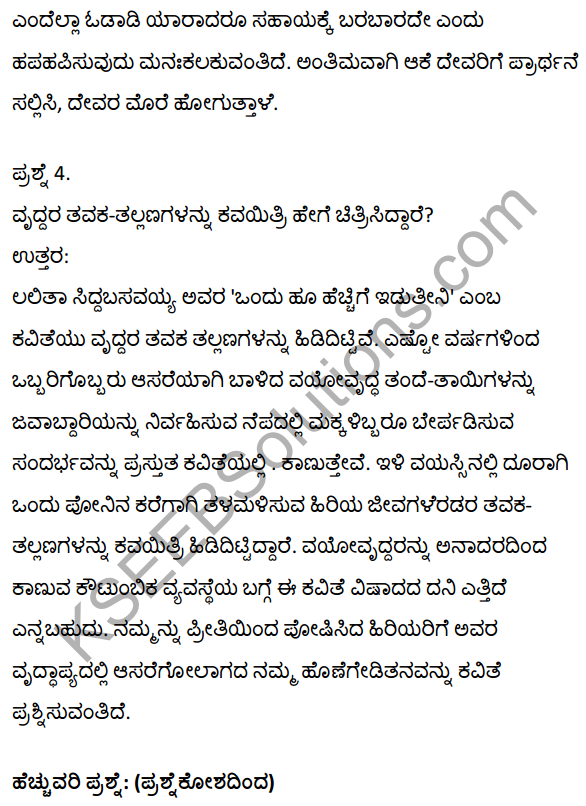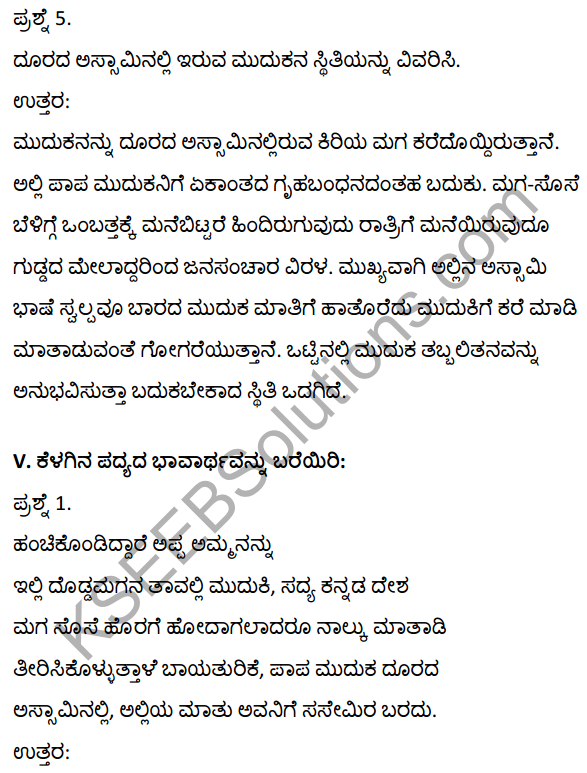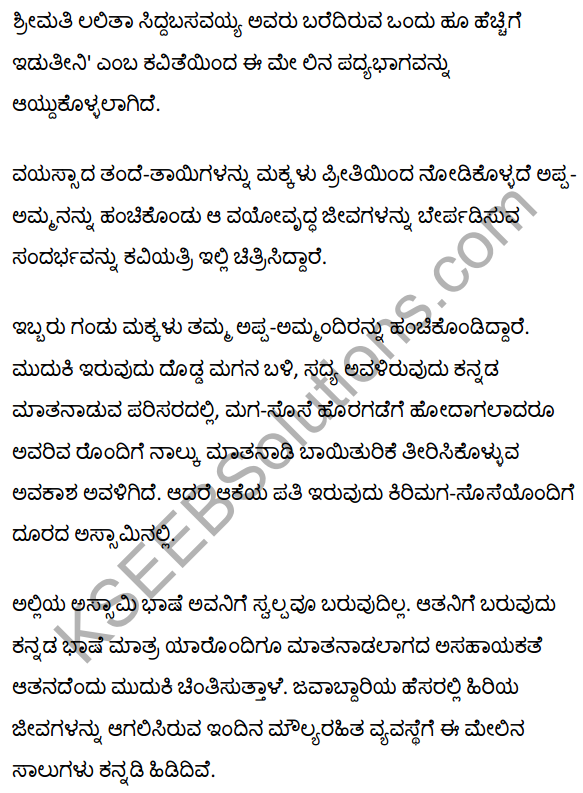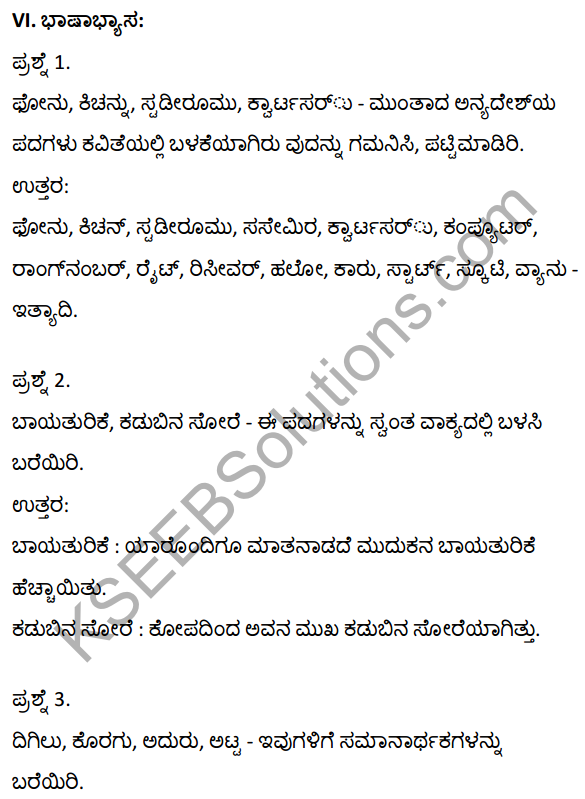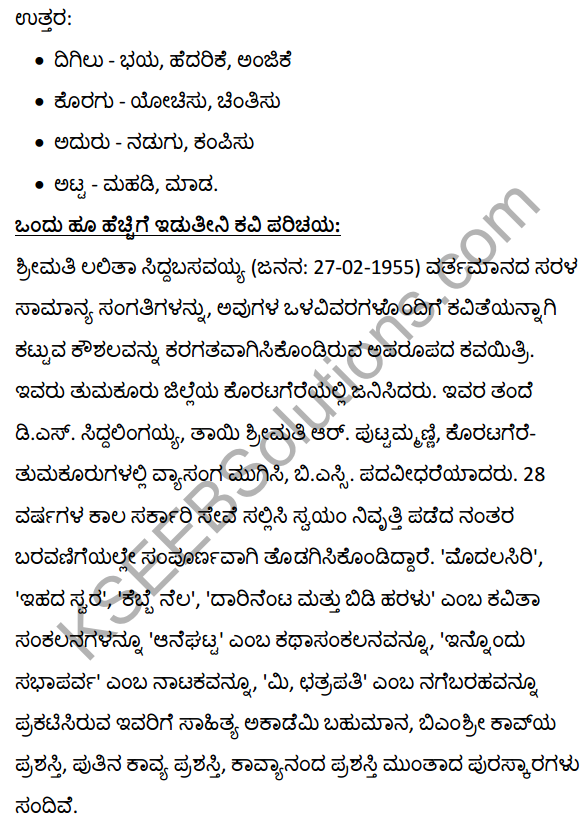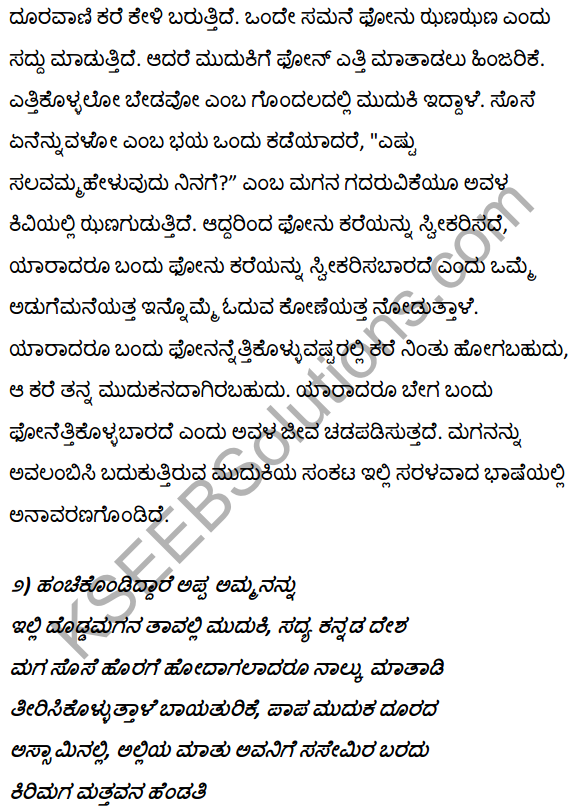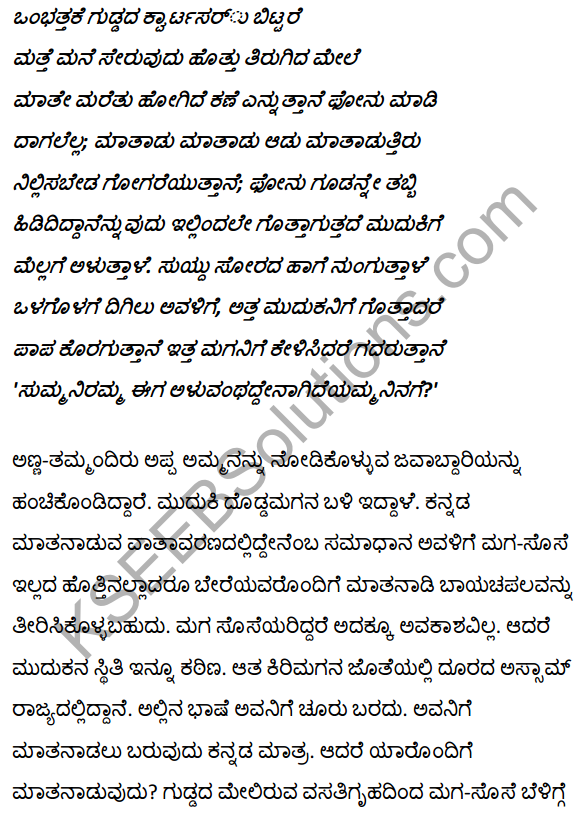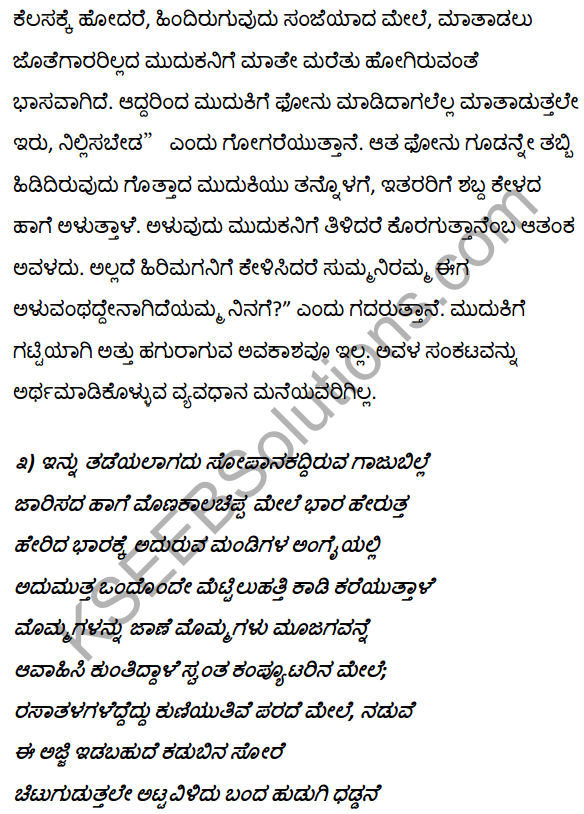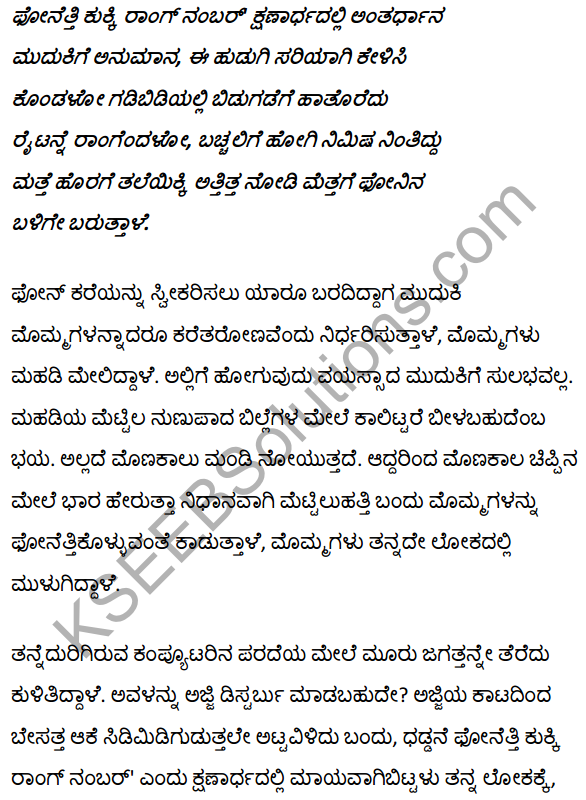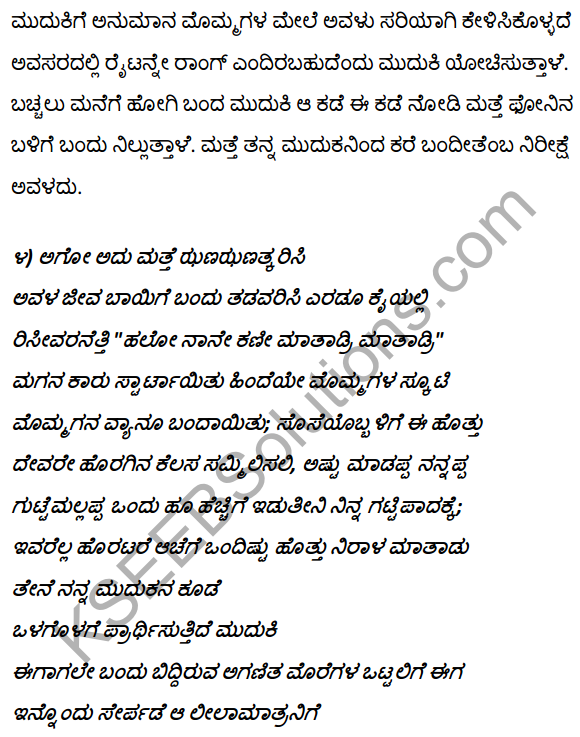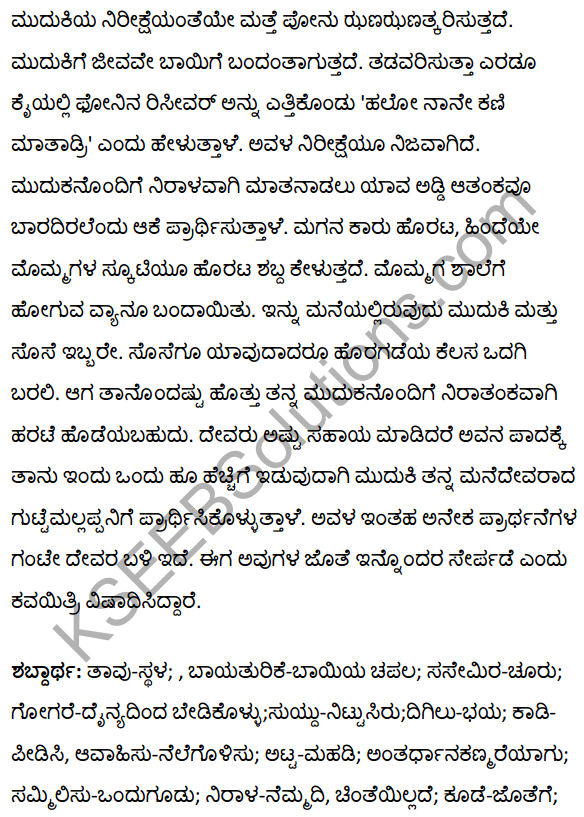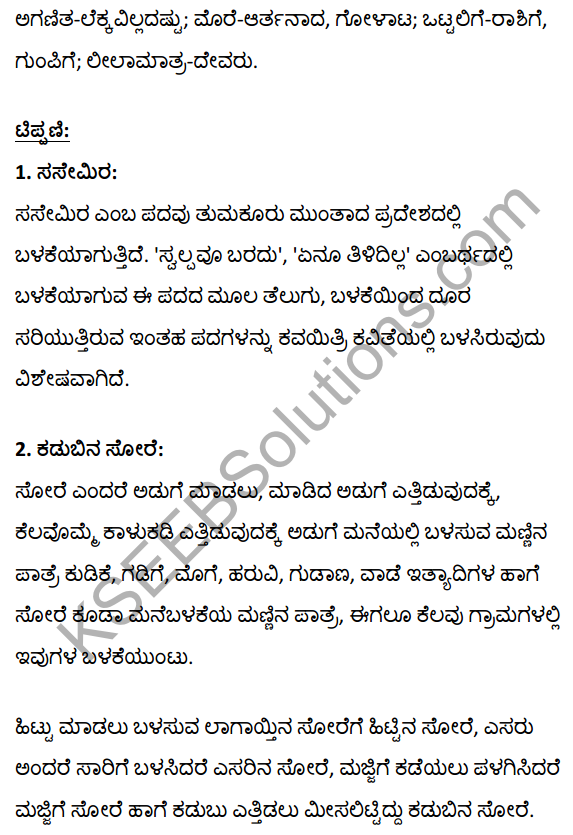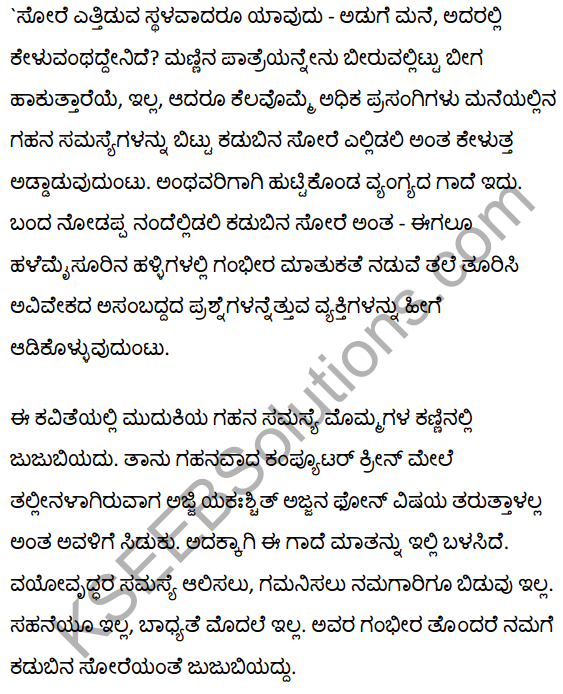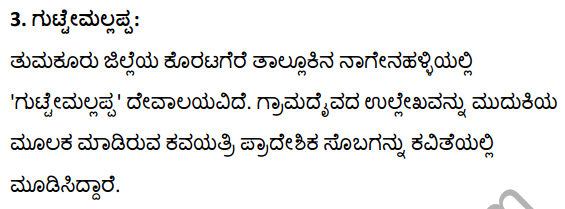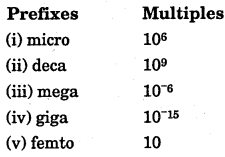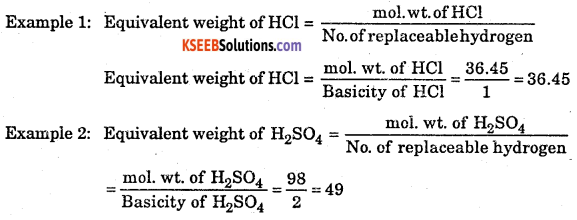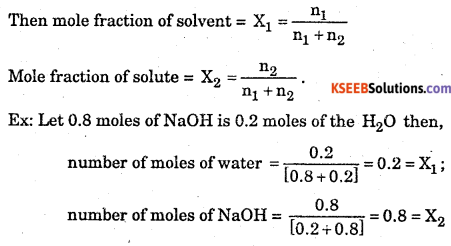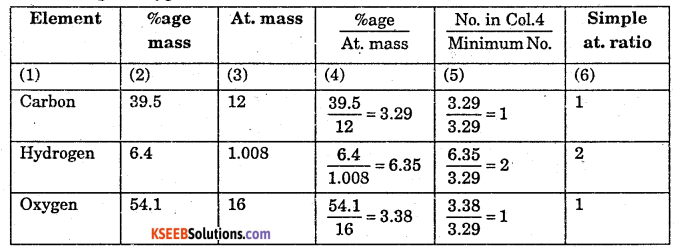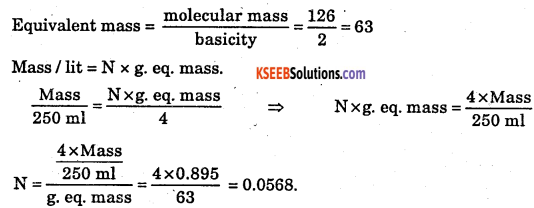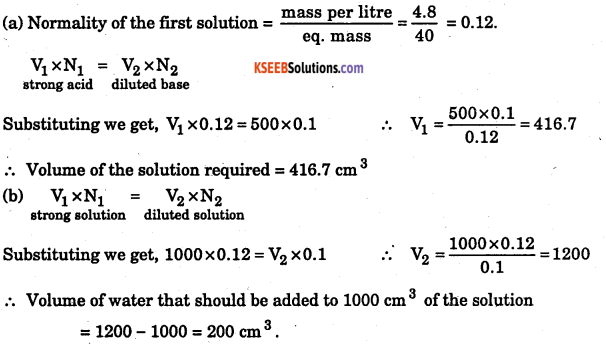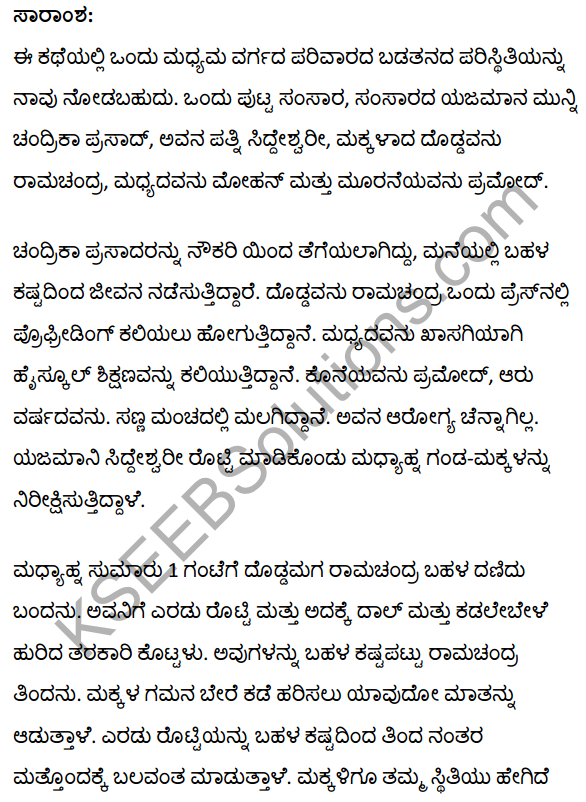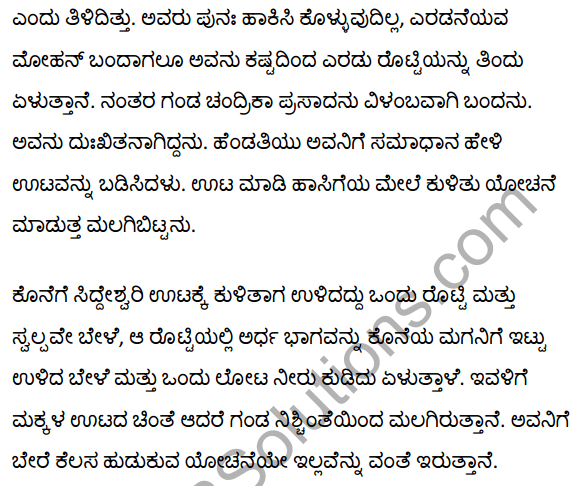You can Download Chapter 15 Waves Questions and Answers, Notes, 1st PUC Physics Question Bank with Answers Karnataka State Board Solutions help you to revise complete Syllabus and score more marks in your examinations.
Karnataka 1st PUC Physics Question Bank Chapter 15 Waves
1st PUC Physics Waves Textbook Questions and Answers
Question 1.
A string of mass 2.50 kg Is under a tension of 200 N. The length of the stretched string is 20.0 m. If the transverse Jerk is struck at one end of the string, how long does the disturbance take to reach the other end?
Answer:
Mass per unit length of the string,
µ = \(\frac{2.50 \mathrm{kg}}{20 \mathrm{m}}\) = 0.125 kg m-1
Given tension, T = 200 N.
The speed of wave on the string is given by,
v = \(\sqrt{\frac{T}{\mu}}\) =\(\sqrt{\frac{200}{0.125}}\) = 40 ms-1
∴ Time taken by the disturbance to reach the other end of the string:
t = \(\frac{\mathrm{s}}{\mathrm{v}}\) = \(\frac{20}{40}\) = 0.5 s
Question 2.
A stone dropped from the top of a tower of height 300 m high splashes into the water of a pond near the base of the tower. When Is the splash heard at the top given that the speed of sound In air Is 340 m s-1? (g= 9.8 ms-2)
Answer:
Time taken to hear the splash at the top =Time taken by the stone to reach the pond + Time taken by the sound to travel to the top from the base of tower,
i e., T = T1 + T2 ……..(1)
T1 : We know that s = u t + 1 / 2 a t2
u = 0, s = 300 m, a = g = 9.8 ms-2
⇒ t = \(\sqrt{\frac{2 \mathrm{s}}{\mathrm{a}}}\) = \(\sqrt{\frac{2 \times 300}{9.8}}\) = 7.82 s
∴ T1 =7.82 s
T1 : s = vt ⇒ t = \(\frac{\mathrm{s}}{\mathrm{v}}\) = \(\frac{300}{340}\) = 0.88 s
∴ T2 = 0.88 s
∴ T1+ T2 = 7.82 + 0.88 = 8.70 s
![]()
Question 3.
A steel wire has a length of 12.0 m and a mass of 2.10 kg. What should be the tension In the wire so that the speed of a transverse wave on the wire equals the speed of sound in dry air at 20°C = 343 m s-1?
Answer:
Mass per unit length of the wire,
µ = \(\frac{2.10 \mathrm{kg}}{12.0 \mathrm{m}}\) = 0.175 kg m-1
The speed of wave on a string is
given by, v=\(\sqrt{\frac{T}{\mu}}\)
Given v = 343 ms-1
∴ T = µv2 =0.175 × 3432
= 20588.575 = 2.06×104 N.
Question 4.
Use the formula v = \(\sqrt{\frac{rP}{\rho}}\) to explain why the speed of sound in air
- Is Independent of pressure,
- Increases with temperature,
- Increases with humidity.
Answer:
Given v = \(\sqrt{\frac{\mathrm{rP}}{\rho}}\) ……….(1)
According ideal gas law, P = \(\frac{\rho \mathrm{RT}}{\mathrm{M}}\) , where
\(\boldsymbol{\rho}\) is the density, T is the temperature, M is the Molecular mass of the gas;
R – universal gas constant.
Substituting for P in (1) we get
v = \(\sqrt{\frac{\mathbf{r} \mathbf{R} \mathbf{T}}{\mathbf{M}}}\)
This shows that v is
- Independent of pressure
- Increases with temperature i.e. v ∝ \(\sqrt{T}\)
- We know that the molecular mass of water (18) is less than that of N2 (28) and O2 (32). therefore as humidity increases, the effective molecular mass of air decreases and hence velocity increases.
Question 5.
You have learnt that a travelling wave in one dimension is represented by a function y = f (x, t) where x and t must appear in the combination x – v t or x + vt, i.e., y = f (x ± v t). Is the converse true? Examine if the following functions for y can possibly represent a travelling wave :
(a) (x – vt )2
(b) log [(x + Vy)/x0]
(c) 1/(x + vt)
Answer:
The converse is not true. For any function to represent a travelling wave, an obvious requirement is that the function should be finite at all times and finite everywhere.
Function a) and b) do not satisfy this requirement and hence cannot represent a travelling wave. Only function c) satisfies the condition.
![]()
Question 6.
A bat emits ultrasonic sound of frequency 1000 kHz in air. If the sound meets a water surface, what is the wavelength of
- The reflected sound,
- The transmitted sound? Speed of sound in air is 340 ms-1 and in water 1486 ms-1.
Answer:
We know that λ = \(\frac{\mathrm{v}}{\mathrm{f}}\)
where,
λ : wavelength
v : velocity
f: frequency
1. Reflected sound :
λ = \(\frac{340}{1000}\) = 0.34 m
(∵ v The reflected sound travels in air)
2. Transmitted sound :
λ = \(\frac{1486}{1000}\) = 1.486 m
(∵ v The transmitted sound travels in water)
Note: When sound moves from one medium to other, the frequency does not change.
Question 7.
A hospital uses an ultrasonic scanner to locate tumours in a tissue. What is the wavelength of sound in the tissue in which the speed of sound is 1.7 km s-1? The operating frequency of the scanner is 4.2 MHz.
Answer:
Given
f = 4.2 × 106 Hz
v = 1.7 × 103 ms-1
we know that, λ = \(\frac{\mathrm{v}}{\mathrm{f}}\)
\(=\frac{1.7 \times 10^{3}}{4.2 \times 10^{6}}\) = 4.05 × 10-4 m
∴ wavelength of sound in tissue = 4.05 × 10-4 m
Question 8.
A transverse harmonic wave on a string is described by y(x, t) = 3.0 sin (36 t + 0.018 x+ π/4 ) where x and y are in cm and t in s. The positive direction of x is from left to right.
- Is this a travelling wave or a stationary wave? If it is travelling, what are the speed and direction of its propagation?
- What are its amplitude and frequency?
- What is the initial phase at the origin?
- What is the least distance between two successive crests in the wave?
Answer:
- Travelling wave: The wave is travelling from right to left with a speed of \(\frac{36 s^{-1}}{0.018 \mathrm{cm}^{-1}}\) = 2000 cm s-1 = 20 ms-1
- Amplitude: 3 Frequency : \(\frac{36}{2 \pi}\) = 5.73 Hz
- Initial phase at origin : π/4
- Distance between two successive crests in the wave = \(\frac{2 \pi}{0.018 \mathrm{cm}^{-1}}\) = 349.06 cm = 3.49 m.
![]()
Question 9.
For the wave described in Exercise 15.8, plot the displacement (y) versus (t) graphs for x = 0,2 and 4 cm. What are the shapes of these graphs? In which aspects does the oscillatory motion In travelling wave differ from one point to another: amplitude, frequency or phase?
Answer:

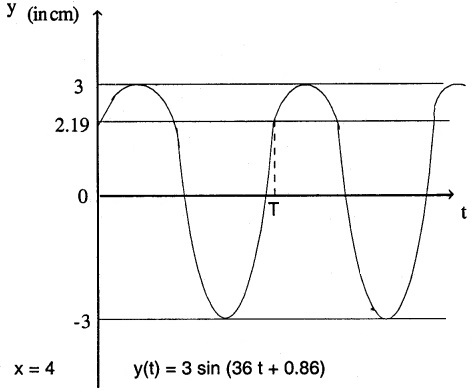
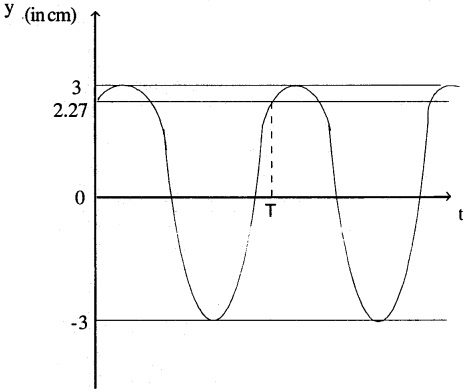
All the graphs have same amplitude of frequency but different initial phase. All graphs are sinusoidal.
Question 10.
For the travelling harmonic wave y(x,t) = 2 cos 2π (10t – 0.0080 x + 0.35) where x and y are In centimetre and t In seconds. Calculate the phase difference between oscillatory motion of 2 points separated by a distance of
a) 4 m
b) 0.5 m
c) λ/2
d) 3λ/2
Answer:
Given
k = 2m × 0.008 cm-1
We know that, k = \(\frac{2 \pi}{\lambda}\) ⇒ λ = \(\frac{2 \pi}{(0.008 \times 2 \pi)}\) = 125cm
Now, (phase difference) = \(\frac{2 \pi}{\lambda}\) × (path difference)
∴ ∆Φ = \(\frac{2 \pi}{\lambda}\) ∆x
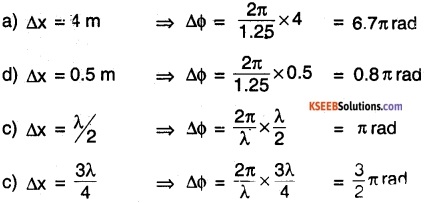
Question 11.
The transverse displacement of a string (clamped at Its both ends) is given by y(x,t) = 0.06 sin \(\left(\frac{2 \pi}{3} x\right)\). cos \((120 \pi \mathrm{t})\) where x and y are in m and t In s The length of the string is 1.5 m and its mass is 3.0 x10-2 kg.
Answer the following :
- Does the function represent a travelling wave or a stationary wave?
- Interpret the wave as a superposition of two waves travelling in opposite directions. What is the wavelength, frequency, and speed of each wave?
- Determine the tension in the string.
Answer:
1. The function represents a stationary wave.
2.
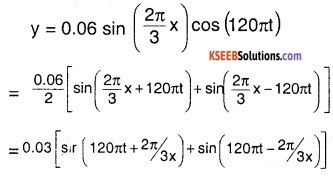
∴ λ = 3 m , f = 60 Hz, v = \(\frac{120 \pi}{2 \pi} \times 3\) = 180 ms-1
for both waves.
3. We know that T = µ v2 where µ = mass per unit length of the string
\(=\frac{3 \times 10^{-2} \mathrm{kg}}{1.5 \mathrm{m}}\) = 2 × 10-2 kgm-1
∴ T = 2 × 10-2 × 1802 = 648 N
![]()
Question 12.
(i) For the wave on a string described in Exercise 15.11, do all the points c n the string oscillate with the same
(a) frequency,
(b) phase,
(c) amplitude?
Explain your answers.
(ii) What Is the amplitude of a point 0.375 m away from one end?
Answer:
Given :
y (x, t) = 0.06 sin \(\left(\frac{2 \pi}{3} x\right)\) cos (120 πt)
i) Amplitude of wave = 0.06 sin \(\left(\frac{2 \pi}{3} x\right)\)
Frequency = 60 Hz.
∴ From the above equation of wave, we see that all points on the string oscillate with same phase and frequency except the nodes (endpoints). We can also see that amplitude of the wave changes for different ‘x’.
ii) Amplitude of a point at 0.375 m
i.e., x = 0.375 m
Amplitude = 0.06 sin \(\left(\frac{2 \pi}{3} x\right)\)
= 0.06 sin \(\left(\frac{2 \pi}{3} \times 0.375\right)\)
= 0.042 m
Question 13.
Given below are some functions of x and t to represent the displacement (transverse or longitudinal) of an elastic wave. State which of these represent (i) a travelling wave, (ii) a stationary wave or (iii) none at all:
- y= 2 cos (3x) sin (10t)
- y= 2\(\sqrt{x-v t}\)
- y = 3 sin(5x – 0.5t) + 4cos(5x-0.5t)
- y = cos x sin t + cos 2x sin 2t
Answer:
1. y = 2cos (3x) sin (10 t)
Represents a stationary wave
2. y = 2\(\sqrt{x-v t}\)
Does not represent any wave.
3. y = 3 sin (5x – 0.5 t) + 4 cos (5x – 0.5t)
= 5 sin \(\left[5 x-0.5 t-\tan ^{-1}(3 / 4)\right]\) Represents a travelling wave,
4. y = cos x sin t + cos 2x sin 2t
Represents superposition of 2 stationary waves.
![]()
Question 14.
A wire stretched between two rigid supports vibrates in its fundamental mode with a frequency of 45 Hz. The mass of the wire is 3.5 × 10-2 kg and its linear mass density is 4.0 × 10-2kgm-1. What is
- The speed of a transverse wave on the string,
- The tension in the string?
Answer:
Given :
f = 45 Hz mass of wire
= m =3.5×10-2 kg
linear mass density
= µ = mass per unit length
= 4 × 10-2 kg m-1
∴ length of the wire
\(=\frac{m}{\mu}=\frac{3.5 \times 10^{-2}}{4 \times 10^{-2}}\)
l = 0.875 m
1. We vibrate in fundamental mode
⇒ λ = 2l

∴ λ =2×0.875 = 1.75 m
∴ Speed of wave
= v =fλ = 45×1.75
= 78.75 ms-1
2. We know that
T = µV2
∴ Tension, T = 4×10-2 × 78.75-2 = 248.06 N
Question 15.
A meter-long tube open at one end, with a movable piston at the other end, shows resonance with a fixed frequency source (a tuning fork of frequency 340 Hz) when the tube length is 25.5 cm or 79.3 cm. Estimate the speed of sound in air at the temperature of the experiment. The edge effects may be neglected.
Answer:
For a closed organ pipe of length ‘l’, the frequency of nth mode of vibration is
f = (2n – 1)\(\frac{v}{4 l}\) ………….(1)
Thus the (n + 1)th mode of vibration of closed pipe is
f = (2n + 1)\(\frac{v}{4 l}\) ………….(2)
Given that the closed pipe vibrates at 340 Hz for tube length = 25.5 cm and 79.3 cm.
Let l1 = 25.5 cm l2 = 79.3 cm
Equating (1) and (2) we get
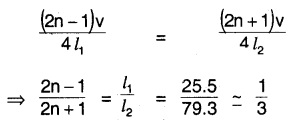
On solving we get n = 1.
On substituting in (1) we have
\(\frac{(2 \times 1-1) v}{4 \times\left(\frac{25.5}{100}\right)}=340\) ⇒ v = 346.8 ms-1
![]()
Question 16.
A steel rod 100 cm long is clamped at its middle. The fundamental frequency of longitudinal vibrations of the rod are given to be 2.53 kHz. What is the speed of sound in steel?
Answer:
Given:
l = 100 cm = 1 m f = 2.53 kHz
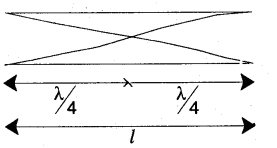
Since the rod is champed at the middle, a node is formed and since the rod is oscillating at a fundamental frequency of 2.53 kHz antinodes are formed at both ends as shown in the figure.
∴ l = λ/4 × 2 = λ/2 ⇒ λ = 2l
λ = 2 × 1 = 2 cm
We know that
v = fλ = 2.53 × 103 × 2
= 5.06 × 10 3 ms-1
Question 17.
A pipe 20 cm long Is closed at one end. Which harmonic mode of the pipe 1s resonantly excited by a 430 Hz source? Will the same source be In resonance with the pipe if both ends are open? (speed of sound In air Is 340 m s-1).
Answer:
Given :
l = 20 cm = 0.2 m
v = 340 ms-1
f = 430 Hz
For a pipe closed at one end :
f = \(\frac{(2 n-1) v}{4 l}\) n = 1, 2, 3 ……
⇒ 430 = \(=(2 n-1) \frac{340}{4 \times 0.2}\)
⇒ n = 1
⇒ Resonance occurs only for first/fundamental mode of vibration.
For a pipe open at both ends,
f = \(\frac{\mathrm{nv}}{2 l}\) n = 1, 2, …..
⇒ 430 = \(\frac{\mathrm{n} \times 340}{2 \times 0.2}\)
⇒ n = 0.51
Since n<1, resonance does not occur.
Question 18.
Two sitar strings A and B playing the note ‘Gd’ are slightly out of tune and produce beats of frequency 6 Hz. The tension In the string A Is slightly reduced and the beat frequency Is found to reduce to 3 Hz. If the original frequency of A is 324 Hz, what Is the frequency of B?
Answer:
Let f1 and f2 be the frequencies of strings A and B respectively.
Given:
f1 = 324 Hz
Beat frequency = fb = 6 Hz
∴ f2= f1 ± fb =(324 ±6) Hz
We know that T ∝ v2 and v ∝ f
(∵ T=μv2 and v=fλ.)
Thus f ∝ \(\sqrt{T}\) …………(1)
Decreasing the tension in string A will decrease the frequency f1.
Since the beat frequency fb is reduced to 3 Hz upon decreasing the tension in string A, f2 = 318 Hz.
Note:
If f2 = 330 Hz, then the beat frequency would have increased when the tension in string A was reduced.
Question 19.
Explain why (or how):
- In a sound wave, a displacement node Is a pressure antinode and vice versa,
- bats can ascertain distances, directions, nature, and sizes of the obstacles without any “eyes”,
- A violin note and sitar note may have the same frequency, yet we can distinguish between the two notes,
- Solids can support both longitudinal and transverse waves, but only longitudinal waves can propagate In gases, and
- The shape of a pulse gets distorted during propagation in a dispersive medium.
Answer:
- In a sound wave, the displacement node is a point where the amplitude of oscillation is zero. But at a displacement node, the pressure changes are maximum. Hence it is also a pressure antinode. Similarly, at displacement antinode, the amplitude of oscillation is maximum whereas pressure changes are minimum. Hence displacement antinode is also a pressure node.
- Bats emit high-frequency ultrasonic waves. These waves are reflected back from the obstacles on their path and are sensed by bats.
- Because they emit different harmonies which can be easily differentiated by human ears.
- This is because solids have both shear and bulk modulus of elasticity whereas gas has only bulk modulus of elasticity.
- A sound pulse consists of waves with different wavelengths. In a dispersive medium, these waves travel with different velocities which distorts the shape of pulse.
![]()
Question 20.
A train, standing at the outer signal of a railway station blows a whistle of frequency 400 Hz In still air.
1. What Is the frequency of the whistle for a platform observer when the train
(a) approaches the platform with a speed of 10 m s-1,
(b) recedes from the platform with a speed of 10 m s-1?
2. What Is the speed of sound in each case? The speed of sound in still air can be taken as 340 m s-1.
Answer:
Given, f = 400 Hz v = 340 ms-1 vs = 10 ms-1 : speed of train .
1.
a) train approaches the platform

b) train recedes from the platform
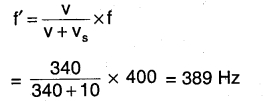
2. The speed of sound does not change, i.e., it is 340 ms-1 for both cases.
Question 21.
A train, standing In a station-yard, blows a whistle of frequency 400 Hz In still air. The wind starts blowing in the direction from the yard to the station with at a speed of 10 ms-1. what are the frequency, wavelength, and speed of sound for an observer standing on the station’s platform? Is the situation exactly Identical to the case when the air Is still and the observer runs towards the yard at a speed of 10 m s-1? The speed of sound in still air can be taken as 340 m s-1.
Answer:
Given f = 400 Hz v = 340 ms-1 vm = 1.0 ms-1 : speed of air
Since there is no relative motion between the source and the observer,
the frequency of sound for the observer = f =400 Hz.
The wind is blowing in the direction from the yard to the station, the effective speed of sound for an observer at the platform = v + vm = 350 ms-1
Wavelength of sound : λ= \(\frac{\left(v+v_{m}\right)}{f}\)
= \(\frac{350}{400}\) = 0.875 m
The situation is not identical to the case when the air is still and the observer runs towards the yard at a speed of 10 ms-1 (= v0). Because here there is a relative motion between the source and the observer.
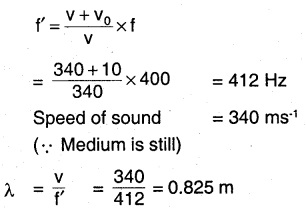
Question 22.
A travelling harmonic wave on a string is described by y(x, t) = 7.5 sin (0.005 x +12t + π /4)
- what are the displacement and velocity of oscillation of a point at x = 1 cm, and t = 1 s? Is this velocity equal to the velocity of wave propagation?
- Locate the points of the string which have the same transverse displacements and velocity as the x a 1 cm point at t = 2 s, 5 s, and 11s.
Answer:
Given:
y (x, t) = 7.5 sin (0.005 x + 12t + π /4)
1. At x=1 cm and t=1s
y (1, 1)= 7.5 Sin(0.005 +12 + π /4)
= 7.5 sin (12.005 + π /4)
= 1.67 cm
Velocity of oscillation : v = \(\frac{\mathrm{d}(\mathrm{Y}(\mathrm{x}, \mathrm{t})}{\mathrm{dt}}\)
= \(\frac{\mathrm{d}}{\mathrm{dt}}\) (7.5 sin (0.005 x + 12t + π/4) dt
= 7.5 × 12 cos (0.005 x+ 12t + π/4)
At x = 1 cm and t = 1 s
v = 7.5 × 12 cos(0.005 + 12 + π/4)
= 87.75 cm s-1
We know that velocity of wave propagation = \(\frac{\mathrm{w}}{\mathrm{k}}\)
Here w = 12 s-1 and k = 0.005 cm-1
∴ Velocity of wave propagation
= \(\frac{12 s^{-1}}{0.005 \mathrm{cm}^{-1}}\) = 24 ms-1
∴ At x = 1 cm and t = 1 s velocity of oscillation is not equal to velocity of wave propagation.
2. In a wave, all the points which are separated by a distance ±λ,±2λ ……..
from x = 1 cm will have same transverse displacements and velocity. For the given
wave , λ= \(\frac{2 \pi}{0.005}\) = ±12.56 cm, +25.12
m….From x = 1 cm will have the same displacements and velocity as at x = 1 cm, t = 2s, 5s and 11 s.
![]()
Question 23.
A narrow sound pulse (for example, a short pip by a whistle) is sent across a medium.
1. Does the pulse have a definite
(i) frequency,
(ii) wavelength,
(iii) speed of propagation?
2. If the pulse rate is 1 after every 20 s, (that is the whistle Is blown for a split of second after every 20 s), is the frequency of the note produced by the whistle equal to 1/20 or 0.05 Hz?
Answer:
1. The pulse does not have definite frequency and definite wavelength but has definite speed of propagation.
2. The frequency of the note is not 1/20 Hz or 0.05 Hz. It is only the frequency of repetition of the whistle.
Question 24.
One end of a long string of linear mass density 8.0 × 10-3 kg m-1 is connected to an electrically driven tuning fork of frequency 256 Hz. The other end passes over a pulley and is kg. The pulley end absorbs all the Incoming energy so that reflected waves at this end have negligible amplitude. At t = 0, the left end (fork end) of the string x = 0 has zero transverse displacement (y = 0) and is moving along positive y-direction. The amplitude of the wave is 5.0 cm. Write down its transverse displacement y as function of x and t that describes the wave on the string.
Answer:
Given : Mass per unit length of string = μ = 8×10-3kgm-1
f = 256 Hz A = 5 cm : amplitude Tension in the string,
T = 90 kg × 9.8 ms-2= 882 N
velocity of the wave :
v = \(\sqrt{\frac{T}{\mu}}\)
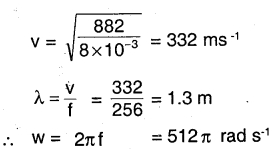
propagation constant,
k= \(\frac{2 \pi}{\lambda}\) = 4.84 m-1
Equation of wave y (x, t) = A sin(wt – kx)
∴ y(x, t) = 5 sin(512 π t – 4.84 x)
with x and y in centimetre and t in seconds.
Question 25.
A SONAR system fixed In a submarine operates at a frequency 40.0 kHz. An enemy submarine moves towards the SONAR with a speed of 360 km h-1. What is the frequency of sound reflected by the submarine? Take the speed of sound in water to be1450ms-1.
Answer:
Given:
f = 40 kHz v = 1450ms-1
Speed of enemy submarine = v0 = 360 km/ hr
=360 × \(\frac{5}{16}\) =100 m/s
Apparent frequency of sound waves:
(source at rest and observer moving towards the source)

Now this frequency is reflected by the enemy submarine and is observed by the SONAR
∴ \(\mathrm{f}^{\prime}=\frac{\mathrm{v}}{\mathrm{v}-\mathrm{v}_{\mathrm{s}}} \times \mathrm{f}^{\prime}\)
Note: Here the observer (SONAR) is at rest and the source is moving towards the observer at a speed of 360 km h-1 = 100 ms-1 (vs)
\(\therefore \mathrm{f}^{\prime}=\frac{1450}{1450-100} \times 42.76 \mathrm{k}=45.93 \mathrm{kHz}\)
![]()
Question 26.
Earthquakes generate sound waves Inside the earth. Unlike a gas, the earth can experience both transverse (S) and longitudinal (P) sound waves. Typically the speed of S wave is about 4.0 km s-1, and that of P wave is 8.0 km s-1. A seismograph records P and S waves from an earthquake. The first P wave arrives 4 minutes before the first S wave. Assuming the waves travel in a straight line, at what distance does the earthquake occur?
Answer:
Let vp =8 km s-1 and vs = 4 k ms-1
t = time gap between arrival of s and p waves = 4 min = 240 s
t = ts – tp = \(\frac{\mathrm{d}}{\mathrm{v}_{\mathrm{s}}}-\frac{\mathrm{d}}{\mathrm{v}_{\mathrm{p}}}\)
where d :
distance of earthquake centre (kms)
∴ 240 = \(\mathrm{d}\left[\frac{1}{4}-\frac{1}{8}\right]\)
∴ d = \(\frac{240}{0.25-0.125}\) = 1920 km
Question 27.
A bat Is flitting about In a cave, navigating via ultrasonic beeps. Assume that the sound emission frequency of the bat Is 40 kHz. During one fast swoop directly toward a flat wall surface, the bat is moving at 0.03 times the speed of sound in air. What frequency does the bat hear reflected off the wall?
Answer:
Given:
f = 40 kHz
velocity of bat = 0.03 velocity of sound i.e., vs = 0.03 v
Apparent frequency of sound hitting the wall
\(f^{\prime}=\frac{v}{v-v_{s}} \times f=\frac{v}{v-0.02 v} \times f\)
= 1.03 \(f^{\prime}\) = 1.03 × 40 k
= 41.24 k Hz
This freuency f1 is reflected e ft tne wall and is recieved by the bat moving towards the wall
∴ \(f^{\prime \prime}=\frac{\gamma+v_{s}}{v} \times f^{\prime}=\frac{v+0.03 v}{v} \times f^{\prime}\)
= 1.01 \(f^{\prime}\) = 1.03 × 41.24 k
= 42.47 k Hz
1st PUC Physics Waves one mark Questions and Answers
Question 1.
What is meant by a wave?
Answer:
The disturbance set up in a medium is called a wave.
Question 2.
What property of the medium is essential for the propagation of mechanical wave?
Answer:
Elasticity and Inertia.
Question 3.
Which physical quantity does not change when a wave travels from one medium to another?
Answer:
Frequency
Question 4.
What is a progressive wave?
Answer:
A wave, which travels continuously in a medium in the same direction, is called a progressive wave.
![]()
Question 5.
If y = 2sin π (40t – 2x) represents a progressive wave. What is its frequency?
Answer:
20 Hz.
Solution:
Given equation is
y = 2 sin π (40t – 2x)
y =2 sin 40π (t – x/20)
Comparing this with y = a sin ω (t -x/v)
ω = 2 πf = 40π
∴ f= 20Hz
Question 6.
Two waves are represented by the equations Y1 = a sin(ωt- kx) and Y2 = a cos (ω t – kx). What is the phase difference between them?
Answer:
π/2 radians.
Y1 = a sin (ω t – kx).
Y2= a cos (ω t – kx).
= a sin(ω t – kx + π /2).
∴ Phase difference between Y1 and Y2 is π/2 rad.
Question 7.
What is meant by ‘Phase of a Particle’ in a wave?
Answer:
The phase of a particle at any instant represents the state of vibration of the particle at that instant.
Question 8.
What is a mechanical wave?
Answer:
A wave which requires a medium for its propagation is called a mechanical wave.
![]()
Question 9.
Give an example of a transverse wave.
Answer:
Light waves.
Question 10.
Give an example of a two-dimensional wave.
Answer:
Water waves.
Question 11.
What is a transverse wave?
Answer:
In transverse waves, particles of the medium are vibrating perpendicular to the direction of wave propagation.
Question 12.
What is the angle between the vibration of the particle of medium and direction of propagation of the wave in a transverse wave?
Answer:
90°
Question 13.
How does velocity of sound vary with pressure?
Answer:
The velocity of sound is independent of pressure.
![]()
Question 14.
How does velocity of sound vary with temperature?
Answer:
The velocity of sound in a gas is directly proportional to the square root of the absolute temperature.
Question 15.
How does velocity of sound vary with humidity?
Answer:
The velocity of sound increases with increase in humidity.
Question 16.
Why sound travels faster in moist air than in dry air?
Answer:
The density of moist air is less than that of dry air. As the velocity of sound in a gas is inversely proportional to the square root of its density, the velocity of sound in moist air is greater than that in dry air.
Question 17.
A wave has a velocity of 330 ms-1 at one atmospheric pressure. What will be its velocity at 4 atmospheric pressure?
Answer:
330 ms-1
[Reason: Velocity of sound in a gas is independent of pressure].
Question 18.
What are the beats?
Answer:
The rise and fall in the intensity of sound due to the superposition of two sound waves of slightly different frequencies traveling in the same direction is known as beats.
Question 19.
What is beat frequency?
Answer:
The number of beats heard per second is called beat frequency.
![]()
Question 20.
Define the beat period.
Answer:
The time interval between two consecutive maxima or minima is called beat period. It is also equal to the reciprocal of beat frequency.
Question 21.
What is the available range of sound frequencies?
Answer:
20 Hz to 20,000 Hz.
Question 22.
By how much does the frequencies of 2 sound sources differ, if they produce 10 beats in 2 seconds.
Answer:
Number of beats per second
\(=\frac{10}{2}=5\)
∴ ∆ f = f1 ~ f2 = 5 Hz
Question 23.
Define reverberation.
Answer:
Reverberation is defined as the persistence of audible sound even after the source has ceased to produce the sound.
Question 24.
What is a stationary wave?
Answer:
The wave formed due to the superposition of two identical waves travelling with the same speed in opposite directions is called a stationary wave or standing wave.
Question 25.
What Is fundamental frequency?
Answer:
The vibration of a body with the lowest frequency is called the fundamental frequency.
Question 26.
What are overtones?
Answer:
Frequencies greater than fundamental frequency are called overtones.
Question 27.
What are harmonics?
Answer:
Overtones, which are an integral multiple of the fundamental frequency, are called harmonics.
Question 28.
The length of the vibrating portion of a sonometer wire Is doubled. How does its frequency change?
Answer:
Halved
[Reason: Frequency f ∝ 1//. As / is doubled f is halved].
![]()
Question 29.
Give the relation between the fundamental note and overtone in an open pipe.
Answer:
\(f^{\prime}=(n+1) f\)
f – fundamental frequency, n = 1,2, 3….
for 1st and 2nd …. overtones.
Question 30.
What is the distance between a node and the neighbouring antinode of a stationary wave?
Answer:
\(\frac{\lambda}{4}\)
Question 31.
The fundamental frequency produced in a dosed pipe is 500 Hz. What Is the frequency of the first overtone?
Answer:
1500 Hz.
[Solution: Frequency of the first over tone in a closed pipe is \(f^{\prime}\) = 3f = 3 × 500 = 1500 Hz].
Question 32.
Find the distance between node and an adjacent antinode if the wavelength in 4m in a stationary wave.
Answer:
Distance between node and adjacent antinode =\(\frac{\lambda}{4}=\frac{4}{4}\) = 1 m
Question 33.
Explain why is it NOT possible to have interference between the waves produced by 2 sitars?
Answer:
Because the waves produced will not have a constant phase difference.
Question 34.
Which harmonies are present in a closed organ pipe?
Answer:
All the odd harmonies are present.
Question 35.
What will be the resultant amplitude when 2 waves y1 = a sin ω t are superposed at any point at a particular instant?
Answer:
y = y1 + y2 = a sin ω t + a cos ω t
= a (sin ω t + cos ω t)
=\(\sqrt{2} \mathrm{a}(\sin (\omega \mathrm{t}+\pi / 4))\)
∴ Resultant amplitude : \(\sqrt{2}\)a
Question 36.
Write 2 characteristics of a medium which determine the speed of sound waves in the medium.
Answer:
Elasticity and inertia.
![]()
Question 37.
State the factors in which the speed of a wave travelling along a stretched Ideal string depends
Answer:
Tension and mass per unit length.
Question 38.
The fundamental frequency of oscillation of a closed pipe is 400 Hs. What will be the fundamental frequency of oscillation of open pipe of the same length?
Answer:
fe = \(\frac{\mathrm{v}}{4 l}\) = 400 Hz
fo = \(\frac{\mathrm{v}}{2 l}\) ⇒ fo = 2 fe = 800 Hz.
Question 39.
Why is it difficult some times to recognise your friend’s voice on phone?
Answer:
Because of modulation.
Question 40.
Which of the following media can pass longitudinal waves only air, water or Iron?
Answer:
Air
1st PUC Physics Waves two marks Questions and Answers
Question 1.
Explain different types of waves (based on medium)
Answer:
Waves are classified into two types:
1. Mechanical Waves:
Waves, which requires a medium for their propagation are called mechanical waves.
e.g.: Waves on the surface of water, Seismic waves (due to earthquake), Sound waves, Waves on stretched string, waves formed in an air column, shock waves.
2. Non-mechanical Waves:
Waves, which do not require a medium for their propagation are called Non-mechanical Waves.
e.g.: Light waves, heat waves, radio waves, X- rays, ultraviolet rays, Infrared rays, etc.
Question 2.
The equation of a progressive wave is y = 0.2 sin(50t-0.5x). Find the amplitude and the magnitude of the velocity, if ‘x’ and ‘y’ are in metres.
Answer:
Given equation is,
y = 0.2 sin(50t – 0.5x)
= 0.2 sin50(t – x/100)
Comparing with y = a sin ω (t – x/v)
amplitude a = 0.2m,
velocity v = 100m/s
Question 3.
State the principle of superposition. Name the phenomenon produced due to the superposition of waves.
Answer:
When two or more waves superpose, he resultant displacement of particle of the medium is equal to the vector sum of the displacements due to individual waves. Superposition of waves leads to the phenomenon of interference, diffraction, beats, and formation of stationary waves are due to the superposition of waves.
![]()
Question 4.
What is a longitudinal wave ? Give an example.
Answer:
If the particles of a medium vibrate along the direction of wave propagation then wave is called longitudinal waves,
e.g: Sound waves in air are longitudinal waves.
Question 5.
The distance between two particles is 0.1m; If the phase difference between these points is π/2 rad calculate the wavelength.
Answer:
∆= 0.1m, Φ = π/2 rad
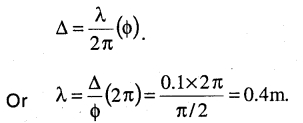
Question 6.
How does its frequency of a tuning fork change when the prongs are
- filed
- waxed.
Answer:
- When the prongs of a tuning fork are filed its frequency increases.
- The frequency of a tuning fork decreases when the prongs are waxed.
![]()
Question 7.
What is meant by beats? What are its applications ?.
Answer:
The periodic rise and fall (Waxing and waning) in the intensity of sound due to the superposition of two sound waves of slightly different frequencies traveling in the same direction is called beats.
The phenomenon of beats can be used.
- To determine the unknown frequency of a tuning fork.
- In tuning musical instruments.
Question 8.
What is the Doppler effect? Give an example.
Answer:
The apparent change in the frequency of sound due to the relative motion between the source and the observer is called the Doppler effect.
E.g.: The apparent frequency of the whistle of a train increases as it. approaches an observer on the platform and decreases when the train passes the observer.
Question 9
What are the uses of the Doppler effect?
Answer:
- Doppler effect is used in a radar system to detect the speed of automobiles and aeroplanes.
- It is used to determine the speed submarines (Using SONAR).
- It is used to determine the speed of stars and planets and other celestial bodies.
Question 10.
When two tuning forks A and X are sounded together produces 6 beats per second. If the frequency of A is 341 Hz. What is the frequency of X?
Answer:
fA = 341 Hz
f=?
and fb = 6 beats/s
fb = fA ~ fx
or f = fA ± fb = 341 ± 6
= 335 Hz or 347 Hz
Question 11.
What are nodes and antinomies in a stationary wave?
Answer:
The points in a stationary wave where the amplitude of vibration of the particles zero are called nodes The points in a stationary wave where the amplitude of vibration of particles is maximum are called antinodes.
Question 12.
An open pipe and a closed pipe have the same fundamental frequency. Explain how their lengths are related?
Answer:
Fundamental Frequency of an open pipe f1 = \(\frac { v }{ { 2l }_{ 1 } } \)
Fundamental Frequency of an closed pipe
f2 = \(\frac{\mathbf{v}}{4 \ell_{2}}\)
Given f1 = f2 ∵ 2l1 = 4l2
\(\frac{\ell_{1}}{\ell_{2}}=\frac{2}{1}\) ⇒ l1:l2 = 2:1
![]()
Question 13.
Mention any four characteristics of a stationary wave.
Answer:
- A stationary wave does not move in any direction.
- There is no flow of energy.
- All particles in a loop are in the same phase & they are in opposite phase with respect to the adjacent loop.
- Amplitude is different for different particles.
Question 14.
The fundamental frequency produced in a closed pipe Is 100Hz. What is the frequencies of first and second overtone?
Answer:
Given, f = 100Hz
For the first overtone f1,
i.e f1 = 3f
f1 = 3 × 100
= 300 Hz
For the second overtone f2,
i.e f2 = 5f
= 5 × 100
= 500 Hz.
Question 15.
The equation for the transverse wave on a string is y \(=4 \sin 2 \pi(t / 0.05-x / 50)\) with length expressed Iff centimetre and time In second. Calculate the wave velocity and maximum particle velocity.
Answer:
Given
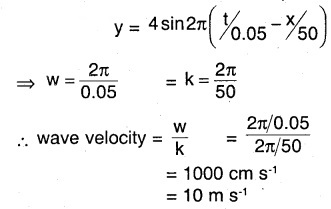
Particle velocity
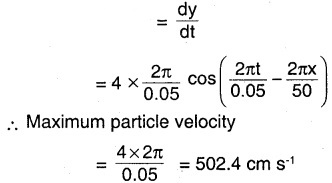
Question 16.
Equation of a wave travelling on a string is y = 0.1 sin(3001 – 0.01 x) cm. Here x is in centimetre and t is in seconds. Find
- wavelength of the wave
- Time taken by the wave to travel 1 m
Answer:
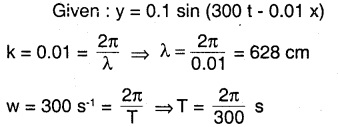
The wave takes T seconds to travel a distance of λ.
∴ Time taken to travel 1 m is
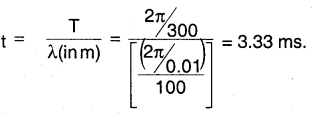
Question 17.
What is meant by RADAR and SONAR? How are long distances measured using these techniques?
Answer:
- RADAR – Radio Detecting and Ranging.
- SONAR – Sound Navigation and Ranging
The waves produced by the devices are sent and are reflected by the bodies and reach them back. If the speed of sound is known and the time taken for to and fro journey, the distance can be estimated.
Question 18.
If the frequency of a tuning fork is 256 Hz and speed of sound in air is 320 ms-1. Find how far does the sound travel when the fork executes 64 vibrations.
Answer:
We know that
v = f λ f= 256 Hz v = 320 ms-1
∴ λ = \(\frac{\mathrm{v}}{\mathrm{f}} \) = \(\frac{320}{256} m \)
Also, the distance covered in n vibrations = n λ
∴ Distance covered in 64 vibrations = \(\frac{64 \times 320}{256} \) = 80 m
1st PUC Physics Waves four/five marks Questions and Answers
Question 1.
Distinguish between longitudinal and transverse waves.
Answer:
1. The vibration of particles of the medium is along the direction of wave propagation in longitudinal waves, whereas in transverse waves, the vibration of particles of the medium is perpendicular to the direction of wave propagation.
2. The wave propagates by forming alternate compressions and rarefactions in longitudinal waves, whereas in transverse waves, the wave propagates by forming alternative crests and troughs.
3. Longitudinal waves travel through solids, gases, and liquids, whereas Transverse waves travel through solids and on 1 liquid surfaces.
4. Longitudinal waves cannot be polarised, whereas Transverse waves can be polarised.
5. Distance between two successive compressions or rarefactions is equal to the wavelength of the wave in longitudinal waves, whereas, in transverse waves, the distance between two successive crests or troughs is equal to the wavelength of the wave.
![]()
Question 2.
Define the following terms.
- Wave amplitude
- Wave period
- Wave frequency
- Wavelength
- Wave velocity
Answer:
1. Wave amplitude (a):
The maximum displacement of a particle of the medium from its mean position is called 1 wave amplitude.
2. Wave period (T):
The time taken by a particle of the medium to complete one vibration or Wave period is the time during which one complete wave is set up in a medium.
3. Wave frequency (f):
The number of vibrations completed by a particle of the medium in one second is called wave frequency or Wave frequency is the number of waves set up in the medium in one second.
4. Wavelength (l):
The distance traveled by the wave in a time equal to its period is called wavelength.
5. Wave velocity (v):
It is the distance traveled by a wave in one second.
Question 3.
What are the characteristics of progressive wave?
Answer:
- A progressive wave is formed due to continuous vibration of the particles of the medium.
- The wave travels with a certain velocity.
- There is a flow of energy in the direction of the wave.
- No particles in the medium are at rest.
- The amplitude of all the particles is the same.
- Phase changes continuously from par¬ticle to particle.
Question 4.
State Newton’s formula for the velocity of sound in a gas. What is the Laplace’s correction? Explain.
Answer:
According to Newton, velocity of sound in any medium is given by v = \(\sqrt{\frac{E}{\rho}}\) where E is the modulus of elasticity and p is the density of the medium.
For gases E = B, bulk modulus
∴ v = \(\sqrt{\frac{\mathrm{B}}{\rho}}\) …………(1)
When sound waves travel through a gas alternate compressions and rarefactions are produced. At the compression region pressure increases and volume decreases and at the rarefaction region pressure decreases and volume increases. Newton assumed that these changes take place under isothermal conditions i.e., at a constant temperature.
Under isothermal condition, B = P, pressure of the gas.
∴ In (1) v= \(\sqrt{\frac{P}{\rho}}\) ………..(2)
This is Newton’s formula for velocity of sound in a gas.
For air at NTP, P = 101.3 kPa and
ρ = 1.293 kgm-3
Substituting the values of P and ρ in . equation (1) we get v = 280m/s. This is much lower than the experimental value of 332 m/s. Thus Newton’s formula is discarded.
Laplace’s correction:
According to Laplace, in a compressed region temperature increases and in a rarefied region it decreases and these changes take place rapidly. Since air is an insulator, there is no conduction of heat. Thus changes are not isothermal but adiabatic.
Under adiabatic condition, B = γ P, where γ is the ratio of specific heats of the gas.
Substituting in equation (1), v = \(\sqrt{\frac{\gamma P}{\rho}}\)
The above equation is called Newton- Laplace’s equation
Substituting the values of P, ρ and γ in the above equation, gives the velocity of sound in air at NTP to be about 331 m/s. This is in close agreement with the experimental value.
Question 5.
Discuss the variation of velocity of sound with,
- Pressure
- Temperature
- Humidity
- Wind
Answer:
1. Effect of Pressure:
According to Boyle’s law, for the given mass of a gas, pressure (P) is inversely proportional to its volume (V) at constant temperature
\(P \propto \frac{1}{V}\)
or PV = constant if m is the mass and
ρ is the density of a gas then,
\(\mathrm{P}\left(\frac{\mathrm{m}}{\rho}\right)\) = constant
For given mass of gas \(\frac{P}{\rho}\) = constant.
∴ In the equation v = \(\sqrt{\frac{\gamma P}{\rho}}\)
γ and \(P / \rho\) are constants.
Thus velocity of sound is independent of pressure at constant temperature,
2. Effect of Temperature:
From Charle’s law, for the given mass of a gas, the volume V is directly proportional to its absolute temperature T at constant pressure.

At constant pressure, velocity of sound

Hence velocity of sound in a gas is directly proportional to the square root of the absolute temperature,
3. Effect of Humidity:
The presence of water vapour (humidity or moisture) in the air reduces the density of air.
∴ The density of dry air is greater than the moist air.
As the velocity of sound in a gas is inversely proportional to the square root of the density, the velocity of sound in moist air is greater than that in dry air. Thus, as the humidity increases, the velocity of sound also increases.
4. Effect of wind:
The velocity of sound is greater in the direction of the wind and lesser in the opposite direction. Let v be the velocity of sound waves and vw the velocity of wind if the wind blows in the direction of sound waves, then the resultant velocity of sound is (v + vw). If the wind blows against the velocity of sound waves, the resultant velocity of sound is (v- vw).
![]()
Question 6.
Explain the theory of beats.
Answer:
Consider two sound waves of the same amplitude ‘a’ and slightly different frequencies f1 and f2 travelling in the same direction. The displacement of a particle in a time t due to the two waves is y1 = a sin ω1 t, and y2 = a sin ω2 t The resultant displacement of the particle due to the superposition of these two waves is,
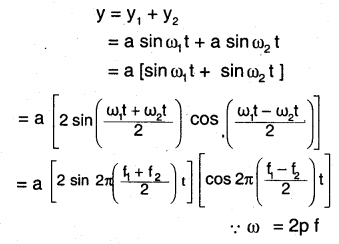
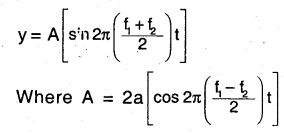
Is the amplitude of the resultant wave. The intensity of resultant sound is maximum when A is maximum.
A is maximum when cos 2 π \(\left(\frac{f_{1}-f_{2}}{2}\right) t=\pm 1\)

The interval between successive maxima is \(\frac{1}{t_{1}-t_{2}}\),
The number of times intensity of sound becomes maximum per second is fB = \(\frac{1}{\mathrm{T}_{\mathrm{B}}}\) = f1 – f2
Hence the beat frequency is the differ-ence between the frequencies of the two waves.
Question 7.
Derive a general expression for apparent frequency when the source moves towards the observer and observer moving away from the source.
Answer:

Consider a source S emitting sound of frequency f. Let v be the velocity of sound. Let the source move towards the observer with velocity vs and the observer move away from the source with velocity vQ. In one second the source travels a distance SS’ = vs and wave travels a distance SP = v. In one second source emits f waves such that these waves will be contained in a length S’ P = v – vs.
The apparent wavelength of these waves is
![]()
These waves approach the observer O with a relative velocity (v – v0)
∴ Number of waves received by the observer in one second or apparent frequency is,

This is the general expression for apparent frequency.
Question 8.
What is Doppler’s effect? Give the expression for the apparent frequency of the note at different cases.
Answer:
The apparent change in the frequency of sound due to the relative motion between the source and the observes is called the Doppler effect.
Case (i) :
When the source moves towards the observer and observer moves away from the source.

Case (ii) :
When the source and ob¬serves move towards each other.

Case (iii) :
When the’source and ob-serves move away from each other

Case (iv):
Source moving away from the observer and the observer moving towards the source

Case (v):
When the source is in motion and the observer is at rest.
a. when the source moves towards the observer

b. when the source moves away from the observer

Case (vi):
when the source is at rest and the observer is in motion a. when the observer moves towards the source

when the observer moves away from the source

where f – real frequency
\(f^{\prime}\) – apparent frequency
v – velocity of sound
vo – velocity of observer
vs – velocity of source.
![]()
Question 9.
What are the beats? Define beat frequency. Explain how the frequency of a tuning fork is determined using beats.
Answer:
The periodic rise and fall (Waxing and waning) in the intensity of sound due to the superposition of two sound waves of slightly different frequencies traveling in the same direction is called beats. The number of beats heard per second is called the beat frequency and is equal to the difference in the frequency is of the two sound waves. To determine the unknown frequency of a tuning fork
Step 1:
Consider a tuning fork A of known frequency f and another fork B of unknown frequency \(f^{\prime}\). When A and B are sounded together let m beats are heard/sec,
∴\(f^{\prime}\) = f±m
Step 2:
Let one of the prong of B is loaded with a bit of wax. The two forks are again sounded together and let m be the number of beats heard/sec.
If m’ > m, i.e. betas increases after adding wax, then real frequency of B is \(f^{\prime}\) = f – m
If nr’ < m, i.e. betas decreases or remains same after adding wax, then real frequency of B is \(f^{\prime}\) = f + m
Question 10.
Distinguish between stationary wave and progressive wave.
Answer:
- A stationary wave is formed by the superposition of two equal progressive waves travelling in opposite directions whereas, a progressive wave is formed due to continuous vibration of the particles of the medium.
- The wave does not travel in any direction in stationary waves whereas, in progressive waves, the wave travels with a certain velocity.
- There is no flow of energy in stationary waves whereas, in progressive waves, there is a flow of energy.
- Particles at the node are at rest in stationary waves whereas, in progressive waves, no particles in the medium are at rest.
- In stationary waves, amplitude is different for different particles, whereas in progressive waves, amplitude of all the particles is the same.
- In stationary waves, all particles in a loop are in the same phase and they are in opposite phase with respect to particles in adjacent loops, whereas in progressive waves, phase changes continuously from particle to particle.
Question 11.
Derive the equation for a stationary wave.
Answer:
The equation of two waves having the same amplitude, wavelength, and speed but propagating in opposite directions is

Where a is the amplitude, λ is the wave-length and v is the velocity of the wave. A stationary wave is formed due to the superposition of these two waves. The resultant displacement of a particle is given by,
y = y1 + y2

where A = 2a cos\(\frac{2 \pi}{\lambda} x\) represents the amplitude of the resultant wave.
Question 12.
What is a closed pipe? Show that the overtones ira closed pipe are odd harmonics of the fundamental.
Ans: A pipe which is open at are end and closed at the other end is called a closed pipe.
Consider a closed pipe of length l. Let v be the velocity of sound in air. The air column in a closed pipe vibrates in such. a way that always antinodes formed at the open end and node is formed at the closed end. Let f1, f2, and f3 be the frequencies and l1, l2 art l3 be the wavelengths of 1st, 2nd and 3rd modes of vibration respectively.

For 1st mode (fundamental mode) l = \(\frac{\lambda_{1}}{4}\) or λ1=4l
but \(\mathrm{f}_{1}=\frac{\mathrm{V}}{\lambda_{1}} \text { or } \quad \mathrm{f}_{1}=\frac{\mathrm{V}}{4l}\) ……….(1)
For i2nd mode (1sl overtone)
\(l=\frac{3 \lambda_{2}}{4} \quad \text { or } \quad \lambda_{2}=\frac{4 l}{3}\)
but \(\mathrm{f}_{2}=\frac{\mathrm{V}}{\lambda_{2}} \text { or } \quad \mathrm{f}_{1}=\frac{3 \mathrm{V}}{4l}=3 \mathrm{f}_{1}\) ………(2)
from (1)
For 3rd mode (2nd overtone)
\(l=\frac{5 \lambda_{3}}{4} \quad \text { or } \quad \lambda_{3}=\frac{4 l}{5}\)
but \(\mathrm{f}_{3}=\frac{\mathrm{V}}{\lambda_{3}} \text { or } \quad \mathrm{f}_{3}=\frac{5 \mathrm{V}}{4l}=5 \mathrm{f}_{3}\) …………(3)
from (1)
From (1), (2) and (3)
f1: f2: f3 = 1:2:3
Therefore in the case of an closed pipe, the frequencies of overtones are odd harmonics of the fundamental.
![]()
Question 13.
What is an open pipe Show that overtones In an open pipe are harmonics of the fundamental? OR Discuss the modes of vibration of air in an open pipe. OR Show that all harmonics are present in an open pipe.
Answer:
A pipe which is open at both ends is called open pipe.
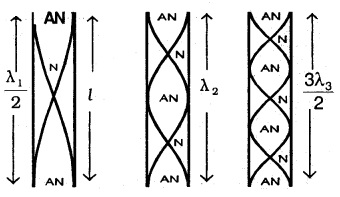
Consider an open pipe of length l. Let v be the velocity of sound in air. The air column in an open pipe vibrates in such a way that always antinodes are formed at the open ends. Let f1 f2 and f3 be the frequencies and λ1, λ2 and λ3 be the wavelengths of the 1st, 2nd and 3rd modes of vibration respectively. For first mode (fundamental mode).
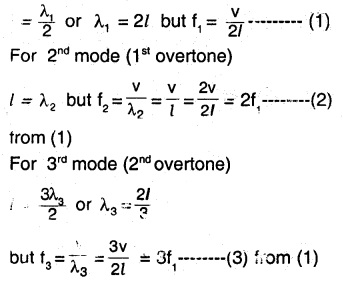
From (1), (2) and (3)
f1: f2: f3 = 1:2:3
Therefore in the case of an open pipe, the frequencies of overtones are simple harmonics of the fundamental.
Question 14.
Derive an expression for fundamental frequency In the case of stretched string.
Answer:
In the fundamental mode of vibration of the string, there will be an antinode in between the two nodes a the fixed points.

If l is the length of the string then
![]()
Velocity of the-wave along the string is
![]()
where T is the tension and m is the mass per unit length (linear density) of the string. Fundamental frequency of vibration of the string is,

Question 15.
Given below are some examples of wave motion. State In each case If the motion is transverse, longitudinal or a combination of both.
- Motion of a kink In a long coil spring produced by displacing one end of the spring sideways.
- Wave produced in a cylinder containing water by moving its piston back and forth.
- Wave produced by a motorboat sailing in water.
- Ultrasonic waves In air produced by a vibrating crystal.
Answer:
- Longitudinal wave
- Transverse wave
- Combination of both
- Longitudinal wave
Question 16.
What do you mean by wave motion? Discuss Its four important characteristics.
Answer:
Wave motion is a motion where the energy is transferred without shifting the material particles.
Four characteristics:
- It is a Simple Harmonic Motion.
- Energy is transported without material shift.
- The velocity of waves depends on the medium (only for longitudinal waves).
- The particles oscillate in SHM.
Question 17.
A simple harmonic wave Is ex-pressed by the equation

y and x are In centimetre and t in seconds. Calculate the following:
i) amplitude
ii) frequency
iii) wavelength
iv) wave velocity
v) phase difference between two particles separated by 17.0 cm
Answer:
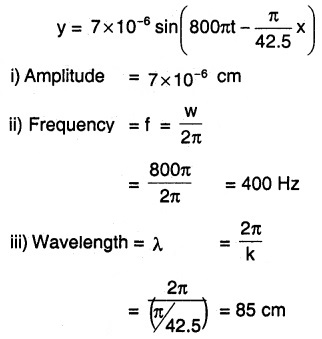
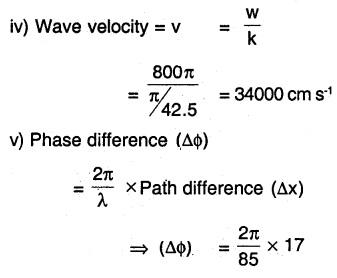
= \(\frac{2 \pi}{5}\) rad.
![]()
1st PUC Physics Waves numerical problems Questions and Answers
Question 1.
A transverse wave is represented by y = 5 sin (50 πt – πx). Find the wavelength and velocity of the wave.
Solution:
Given equation is,
y = 5 sin (50 πt – πx)
Comparing with the standard transverse wave equation,
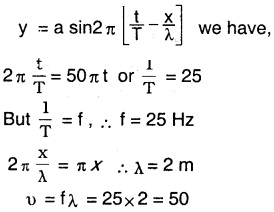
∴ Velocity of the wave, u = 50 m/s
Question 2.
A wave travelling at a speed of 200 m/s has a frequency of 1000 Hz. Its amplitude is 2 units. Write down the wave equation.
Solution:
Standard wave equation is y = a sin 2πt \(\left[\frac{t}{T}-\frac{x}{\lambda}\right]\)
Given a = 2 units.
Frequency = 1/T = 1000 Hz
Velocity, u= 200 m/s

Therefore the wave equation is

Question 3.
The distance between two particles on a string is 10 cm. Find the phase difference between these particles if the frequency of the wave is 400 Hz and speed Is 100m/s.
Solution :
If the distance between two points is ∆x, the phase difference is given by
\(\Delta \phi=\frac{2 \pi}{\lambda} \Delta x\)
Here, Wavelength \(\lambda=\frac{v}{f}=\frac{100}{400}=0.25 \mathrm{m}\)
path difference \(\Delta x=10 \mathrm{cm}=0.1 \mathrm{m}\)
∴ Phase difference \(\Delta \phi=\frac{2 \pi}{0.25} \times 0.1\)
= 0.8π radians
=144°.
Question 4.
A sinusoidal wave propagating through air has a frequency of 200Hz. If the wave speed is 300m/s, how far apart are two points in the medium with a phase difference of 45° and 60°?
Solution:
v = 300m/s, f = 200Hz, Φ1=45°, Φ2=60°
v = f λ
∴ wavelength \(\lambda=\frac{\mathrm{v}}{\mathrm{f}}=\frac{300}{200}=1.5 \mathrm{m}\)
path difference = \(\frac{\lambda}{2 \pi}\) phase difference

∴ Distance between the points
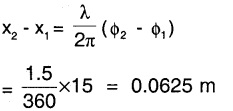
![]()
Question 5.
A wave traveling along a string is described by y(x,t) = 0.00327 Sin(72x-2.72t) in which the numerical constants are in SI units (i.e.,\ 0.00327m, 72.1 rad/m and 2.72 rad/s.) Find the amplitude, wavelength, period and speed of the wave.
Solution:
The equation for a wave travelling along the +ve x direction is
y(x, t) = a sin(kx – ωt)-(1)
The given equation is
y(x, t) = 0.00327sin(72.1 x -2.72t) – (2)
comparing equation (1) and equation (2)
1. Amplitude a = 0.00327 m
2. Wavelength:
We have k =72.1 rad m-1
ω = 2.72 rad s-1

3. period, T = \(\frac{2 \pi}{\omega}\)
\(=\frac{2 \pi}{2.72} \quad=2.31 \mathrm{sec}\)4. Frequency f = \(\frac{1}{T}\)
\(\frac{1}{2.31}=0.4329 \mathrm{Hz}\)
5. Speed of the wave: from the equation
v = fλ
= 0.4329×0.0872
= 0.0377ms-1.
Question 6.
A sinusoidal wave propagating through air has a frequency of 150HZ. If the wave speed is 200 ms-1 how far apart are two points in the medium which have a phase difference of 45° and 150°?
Solution:
f =150Hz, v = 200ms-1 φ1 =45° φ2=150°
v= fλ
wave length \(\lambda=\frac{v}{f}=\frac{200}{150}=1.333 \mathrm{m}\)
path difference =\(\frac{\lambda}{2 \pi}\) phase difference

∴ Distance between the points is
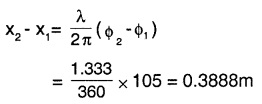
Question 7.
A wave travelling along a string is represented by the equation,
y = 0.08 Sin (5t – 3x) Where x and y are in metre and t is in second.
- At t = 0.1 sec, find the displacement at x = 0.2m
- At x s 0.1m, find the displacement at t = 0.4 sec.
Answer:
1.
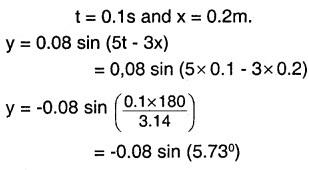
(∵sin (- θ) = -sin (θ) and sine function is in radian. It is converted into degree by multiplying by 180/3.14)
y =-7.98x 10-3m.
2. t = 0.4s and x = 0.1m.
y = 0.08 sin (5t – 3x) = 0.08 sin (5 × 0.4 – 3 × 0.1)
y = 0.08 sin (2 – 0.3) = 0.08 sin (1.7)
y = 0.08 sin \(\left(\frac{1.7 \times 180}{3.14}\right)\) = 0.08 sin (97.45°)
y = 0.08 cos (7.45°) = 0.07932 m
(∵sin (90 + θ) = cos (θ)).
Question 8.
A train moving at a speed of 72kmph towards a situation sounding a whistle of frequency 600 Hz. What are the apparent frequency of the whistle as heard by a man on the platform when the train
- approaches him?
- recedes from him? (speed of sound In air Is 340 ms-1).
Answer:
Vs= 72m/hr = 72x 1000m/3600s,
= 20m/s, V = 340m/s, f = 600Hz
1. Apparent frequency when train approaches the observer
\(f^{\prime}=\left(\frac{V}{V-V_{s}}\right) f=\frac{340 \times 600}{340-20}=637.5 \mathrm{Hz}\)
2. Apparent frequency when train recedes from observer
\(\mathrm{f}^{\prime}=\left(\frac{\mathrm{V}}{\mathrm{V}+\mathrm{V}_{\mathrm{s}}}\right) \mathrm{f}=\frac{340 \times 600}{340+20}=566.7 \mathrm{Hz}\)
Question 9.
Find the ratio of velocity of sound in oxygen and velocity of sound In hydrogen at S.T.P. Given the molecular weight of Oxygen is 32 and that of Hydrogen is 2.
Solution :
Let v0 and vH be the velocities of sound in oxygen and hydrogen respectively
Then
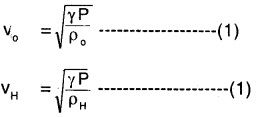
Where Po and pH are the densities of oxygen and Hydrogen respectively. X is the ratio of specific heats which is same for hydrogen and oxygen. But density is directly proportional to the molecular weight.

![]()
Question 10.
At what temperature will the velocity of sound in air reduces to half of its value at 0° C?
Solution :
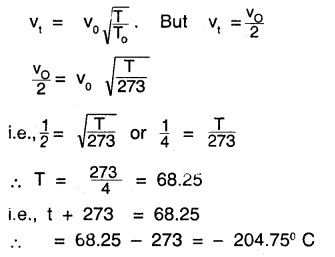
Question 11.
Two tuning forks X and Y sounded together produce 10 beats per second. When Y is slightly loaded with wax, the number of beats reduces to 6 per second. If the frequency of X is 480 Hz, find that of Y.
Solution :
Frequency of x = 480 Hz
No. of beats with y = 10
∴ Frequency of y = 480+10 or 480-10
i.e., 490 or 470
On loading y, number of beats = 6
Frequency of y after loading = 486 or 474
∴ The frequency of y before loading can not be 470, because if it were 470 before loading, it must be less than 470 after loading.
∴ Actual frequency of y = 490 Hz.
Question 12.
Two tuning forks A and B gives 4 beats per second. The frequency of A is 510 Hz. When B Is filed 4 beats per second are again produced. Find the frequency of B before and after filing.
Solution:
Frequency of A =510 Hz.
Beats per second = 4
Therefore the frequency of B before filing,
= 510 + 4 or 510 – 4
= 514 or 506
After filing B, 4 beats are produced again the frequency of B after filing
=510 + 4 or 510 – 4
= 514 or 506
The frequency of B before filing can not be 514 Hz because if it is 514 before filing, after filing its frequency must be more than 514.
Therefore the frequency of B before filing must be 506 Hz and after filing it is 514 Hz.
Question 13.
Two sound waves of wavelength 1.34 m and 1.36 m produces 4 beats per second. Calculate the velocity of sound in the medium.
Solution :
Let v be the velocity of sound in the given medium. Then Frequency of the first wave
\(f_{1} \quad=\frac{v}{\lambda_{1}}=\frac{v}{1.34}\)
Frequency of the second wave
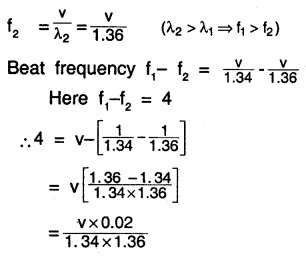
Velocity of sound v = \(\frac{4 \times 1.34 \times 1.36}{0.02}\)
= 364.5 ms-1
Question 14.
A set of 65 tuning forks are arranged In the Increasing order of frequencies such that each gives 3 beats per second with the previous one. Find the frequency of the first tuning fork If the frequency of the last tuning fork Is one Octave above the first one.
Solution :
Let N be the frequency of the first tuning fork. As each tuning fork is giving 3 beats with the preceding one, and they are arranged in the ascending order of frequencies,
Frequency of the second tuning fork = N + 3
Frequency of the third T.F. = N + 6
= N + 3 × 2
Frequency of the fourth T.F = N+9
= N + 3 × 3
Similarly Frequency of the 65th T.F. = N + (65-1 ) × 3
= N + 64 × 3 = N+192 ……………….(1)
But the frequency of the last tuning fork (65th) is one octave above that of the first one.
∴ Frequency of the 65th T.F.= 2N ……………(2)
From (1) and (2) 2N = N + 192
N = 192
∴ Frequency of the first tuning fork = 192 Hz.
![]()
Question 15.
A source of ultrasonic wave is emitting ultrasonic waves of frequency 30 kHz. It is placed in a moving car. With what velocity is the car moving If the frequency appears to be 20 kHz to a stationary observer? Velocity of sound in car 340 ms-1.
Solution:
Here the listener is at rest and the source is moving. As the apparent frequency is lesser than the actual frequency, the source is moving away from the listener.
To find the velocity with the source is moving:
The apparent frequency is given by,
\(\mathrm{f}^{\prime}=\mathrm{f} \frac{\mathrm{v}}{\mathrm{v}+\mathrm{v}_{\mathrm{s}}} \quad \therefore \frac{\mathrm{f}^{\prime}}{\mathrm{f}}=\frac{\mathrm{v}}{\mathrm{v}+\mathrm{v}_{\mathrm{s}}}\)
Here, \(f^{\prime}\) is the apparent frequency = 20 kHz
f is the actual frequency = 30 kHz
v is the velocity of sound = 340 ms-1
On substituting the values, \(\frac{20}{30}=\frac{340}{340+v_{s}}\)
cross multiplying, 2(340 + vS) = 3 × 340 2 × 340 + 2vs = 3 × 340
2 . vs = 3 × 340 – (2 × 340) or 2 . vs = 340
vs =\(\frac{340}{2}\) = 170ms-1
∴ The car is moving with a velocity of 170ms-1 away from the listener.
Question 16.
An engine moving with a speed of 25 ms-1 sends out a whistle at a frequency of 280 Hz. Find the apparent frequency of the whistle for a stationary observer
- when the engine Is approaching him and
- when it is moving away from him. The velocity of sound is 330 ms-1.
Solution :
1. When the source is moving towards the observer,
apparent frequency \mathrm{f}^{\prime}=\mathrm{f} \frac{\mathrm{v}}{\mathrm{v}-\mathrm{v}_{\mathrm{s}}}
Here source velocity vs = 25 ms-1,
velocity of sound v = 330 ms<sup.-1
frequency f = 280 Hz.
\(\therefore \mathrm{f}^{\prime}=\left(\frac{330}{330-25}\right) \times 280=302.95 \mathrm{Hz}\)
2. When the source is moving away from the observer, apparent frequency is given by,

Question 17.
The apparent frequency of the whistle of an engine changes in the ratio 6:5 as the engine passes a stationary observer. If the velocity of sound is 330ms-1 what is the velocity of the engine?
Solution:
Let f be frequency of the sound emitted by the engine and vs be its velocity. The apparent frequency f of the whistle as the engine is approaching the observer is, \(\mathrm{f}^{\prime}=f \frac{\mathrm{V}}{\mathrm{v}-\mathrm{v}_{\mathrm{s}}}\)
But v = 330 ms-1
\(\therefore \mathrm{f}^{\prime}=\mathrm{f} \frac{330}{330-\mathrm{v}_{\mathrm{s}}}\) ………(1)
Let f” be the apparent frequency of the sound heard when the engine is moving away from the observer. Then
But v = 330 ms-1
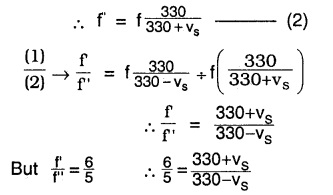
Cross multiplying
6 × (330 – vs) = 5 × (330 + vs)
330 × 6 – 6Vs = 5 × 330 + 5 vs
330 × 6 – 330 × 5 = 5vs + 6vs
330 (6 – 5) = 11vs
330 × 1 = 11 vs
∴ vs \(=\frac{330}{11}\) = 30 ms-1
Question 18.
Two cars approach each other with a common speed of 20ms1. The first car sounds a horn and a passenger in the other car estimates it to be 700 Hz. The speed of sound is 332 ms-1.
- Calculate the actual frequency of the horn
- When the cars move away from each other, what Is the estimated frequency by the same passenger?
Answer:
1. To find true frequency f:

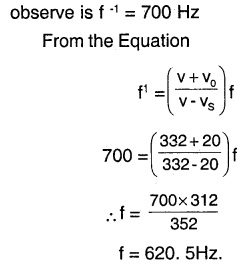
2.
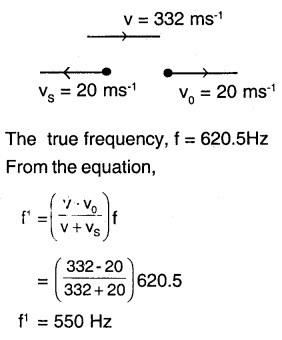
Question 19.
An observer standing by the side of a highway estimates a drop of 20% in the pitch of the horn of a car as it crosses him. If the velocity of sound is 330 m/s, calculate the speed of the car.
Answer:
Given :
v = 330 m/s
Let f1 and f2 be the apparent frequencies heard ty the observer, before and after the source crossing respectively.
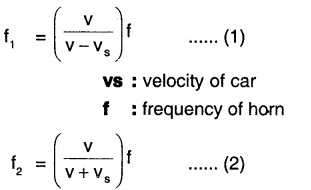
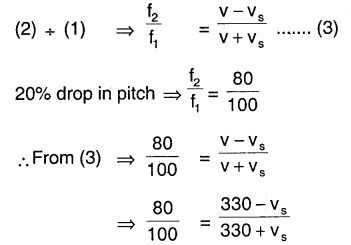
Solving this we get vs = 36.67 ms-1
![]()
Question 20.
A person standing in front of a mountain at a certain distance beats a drum at regular intervals. The drum¬ming rate is gradually increased, and he finds that the echo is not heard distinctly when the rate becomes 50 per minute. He then moves nearer to the mountain by 100 meters, and finds that the echo is again not heard when the drumming rates become 60 per minute. Calculate:
- The distance between the mountain and the initial position of the man,
- Velocity of sound.
Answer:
Let ‘s’ be the distance between the man and the mountain and let ‘v’ be the velocity of sound.
Given :
Drumming rate = 50 per minute.
∴ Interval between successive beats
\(=\frac{60}{50}=1.2 / \mathrm{sec}\)
Time taken by the echo \(=\frac{2 \mathrm{s}}{\mathrm{v}}\)
Given that when the drumming rate is 50 per minute, echo is not heard by the man ⇒ beats overlap in time frame

Similarly when the person moves 100 m
towards the mountain, with drumming rate = 60 per minute

Substituting this in (1) we get.
v = 1000 m/s
Question 21.
An open pipe Is 30 cm long. Find the fundamental frequency of vibration. Which harmonic is excited by a tuning fork of frequency 22 kHz? velocity of sound is 340 ms-1.
Solution:
The fundamental frequency of an open pipe is
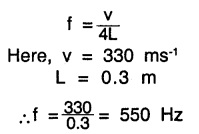
The frequency of the nth mode of vibration is given by

Thus the 2.2 kHz source will produce 4th harmonic.
Question 22.
Two open pipes when sounded together produce 10 beats. If the lengths of the pipes are In the ratio of 4:5, calculate their frequencies.
Solution :
Let f1 and f2 be the fundamental frequencies of the two pipes and L1 be their lengths.
Then,

Then,
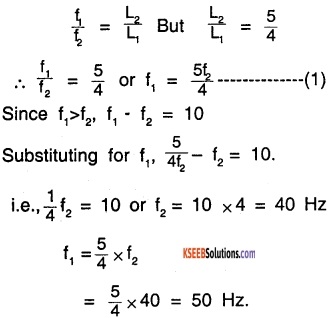
Question 23.
Two tuning forks A and B gives 6 beats per second. A. is in resonance with a closed pipe of length 15 cm. and B Is In resonance with an open pipe of length 30.5 cm. Calculate the frequencies of A and B.
Solution:
Let f1 and f2 be the frequencies of the tuning forks A and B respectively.
Then, f1 – f2 = 6 ………….(1)
But tuning fork A is in resonance with a closed pipe of length 15 cm
\(\therefore f_{1}=\frac{V}{4 L_{1}}=\frac{v}{4 \times 0.15}=\frac{v}{0.6}\)
Similarly tuning fork B is in resonance with an open pipe of length 30.5 cm
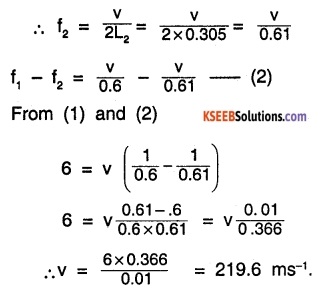
Frequency of the tuning fork A is
\(\mathrm{f}_{1}=\frac{\mathrm{v}}{0.6}=\frac{219.6}{0.6}=336 \mathrm{Hz}\)
Frequency of the tuning fork B is
\(\mathrm{f}_{2}=\frac{v}{0.61}=\frac{219.6}{0.61}=360 \mathrm{Hz}\)
Question 24.
A closed pipe resonates In its fundamental mode of frequency 500 Hz In air. What will be the fundamental frequency if air is replaced by hydrogen at the same temperature? Density of air = 1.20 kg/m3 and density of hydrogen = 0.089 kg/ m3.
Solution:
Let va be the velocity of sound in air and vH be the velocity of sound in hydrogen. Then fundamental frequency of the pipe filled with air is,

If f is the fundamental frequency of the closed pipe, filled with hydrogen then,
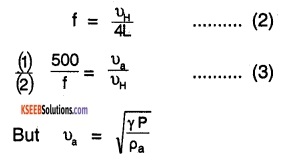
Where γ is the ratio of specific heats, P is the pressure and Pa is the density of air.
Similarly, \(v_{H}=\sqrt{\frac{y P}{\rho_{H}}}\)
\(\therefore \quad \frac{v_{\mathrm{a}}}{v_{\mathrm{H}}}=\sqrt{\frac{\rho_{\mathrm{H}}}{\rho_{\mathrm{a}}}}=\sqrt{\frac{0.089}{1.20}}\) =0.2734
On substituting in equation (3),
\(\frac{500}{f}=0.2734\)
\(f=\frac{500}{0.2734}\)
=1836 Hz.
![]()
Question 25.
A string vibrates with a frequency of 200 Hz. When its length Is doubled and Its tension is altered it begins to vibrate with a frequency of 300 Hz. What Is the ratio of new tension to the original tension?
Solution:
\(f=\frac{1}{2 L} \sqrt{\frac{T}{m}}\)
Let L be the length of the string and m be the mass per unit length and T1 be the original tension. Then,
\(200=\frac{1}{2 L} \sqrt{\frac{T_{1}}{m}}\) …………..(1)
In the Second case length = 2L, let T2 be the tension
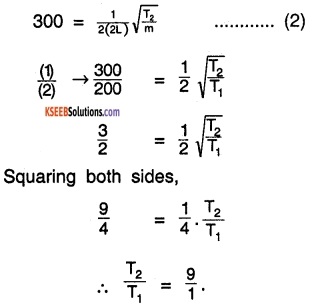
Question 26.
Two tuning forks A and B when vibrated together gives 6 beats per second. The tuning fork A is in unison with an air column in a closed pipe 0.15m long vibrating In fundamental mode and tuning fork B is in unison with an air column In an open pipe 0.61 m long vibrating In first overtone. Calculate the frequencies of the tuning forks.
Solution:
Let f and f be the frequencies of tuning forks A and B respectively.
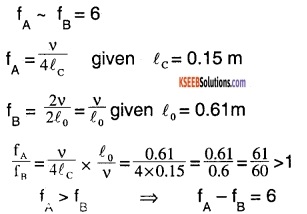
\(\frac{\omega 1}{m} f_{m}-f_{c}=6 \quad \Rightarrow \frac{f_{B}}{f(1)}=6\)
fB = 360 Hz
∴ fA = 6+fB = 366 Hz.
Question 27.
Two tuning forks, when sounded together, produce 5 beats per second. A sonometer wire of length 0.24 m is in unison with one of them. If the length of the wire is increased by 0.01 m, ft is in unison with the other fork. Find the frequencies of the forks.
Solution:
Let f1 and f2 be the frequency of the two turning forks.
given f1 ~ f2 =5 ……….(1)
l1 = 0.24m, l2 = 0.25m.
Frequency of vibration of the wire is given by
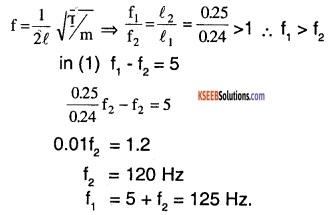
Question 28.
A closed organ pipe of length 0.42 m and an open organ pipe, both contain air at 35° C. The frequency of the first overtone of the closed pipe is equal to the fundamental frequency of open pipe. Calculate the length of open pipe and the velocity of sound in air at 0° C. Given that closed pipe is in unison in its fundamental mode with a tuning fork of frequency 210 Hz.
Solution:
Let l1 be the length of the closed pipe and l2 be the length of the open pipe. l1 = 0.42m
Let vt be the velocity of sound in air at t° c, t = 35° c
Let f be the fundamental frequency of the closed pipe
\(t=v_{1} / 4 / 1\)
Let f be the fundamental frequency of the open pipe
\(f^{\prime}=v_{1} / 2 l_{2}\)
Given that frequency of first overtone of the closed pipe is equal to the fundamental frequency of the open pipe

Also given that closed pipe is in unison with a tuning fork of frequency 210Hz i.e.,
f = 210 Hz
∴ In (1) 210 \(=\frac{v_{t}}{4 \times 0.42}\)
vt=840×0.42 =352 .8m /s
Velocity of sound in air at 0°C is
\(v_{0}=v_{t} \sqrt{\frac{273}{273+t}}\)
\(=3528 \sqrt{\frac{273}{273+35}}=3322 \mathrm{m} / \mathrm{s}\)
Question 29.
A stretched wire emits a note of fundamental frequency 35 Hz. When the tension Is increased by 0.5 kg. wt., the frequency of the fundamental rises to 40 Hz. Find the initial tension and the length of the wire. (Mass per unit length of the wire = 1.33 × 10-3 kg/m).
Solution:
Fundamental frequency of vibration in a stretched string is
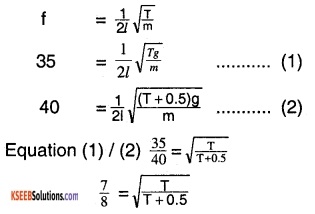
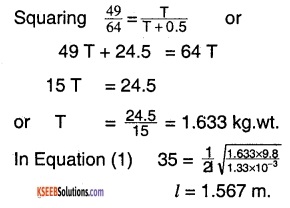
Question 30.
One end of a horizontal wire is fixed and the other passes over a smooth frictionless pulley and has a heavy body attached to it. The fundamental frequency is 400 Hz. When the body is totally immersed in water, the frequency drops to 350 Hz. Find the density of the body. \(\left[\rho_{\omega}=19 / \mathrm{cm}^{3}\right]\).
Answer:
Given :
f1= 400 Hz. f2 = 350 Hz
\(\rho_{\omega}=^{1} 9 / \mathrm{cm}^{3}\)
We know that, for a string under tension T, the frequency of oscillation
\(\mathrm{f}=\frac{\mathrm{n}}{21} \sqrt{\frac{\mathrm{T}}{\mu}}\)
l: length of wire, \(\mu\) : mass per unit length
∴ T1 = mg T2 = mg – B
Now m: \(\mathrm{v} \rho\) v: volume ρ: mass density
∴ mg = \(\mathrm{v} \rho\)g B = \(\mathrm{v} \rho\)ωg
g = 9.8 m s-2
Given:

Question 31.
A whistle, emitting a sound of frequency 300 Hz is tied to a string of 2 m length and is rotated with an angular velocity of 15 rad / second in the horizontal phase. Find the range of frequencies heard by the observer stationed at a large distance from the whistle.
Answer:
Given:
radius r = 2 m ;
w = 15 rad s-1; v = 330 ms-1
We know that vs = r w = 30 m s-1
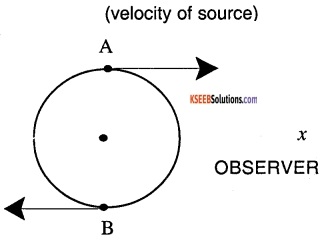
The observer will receive maximum frequency when the source is approaching (A) and minimum when its receding (B).
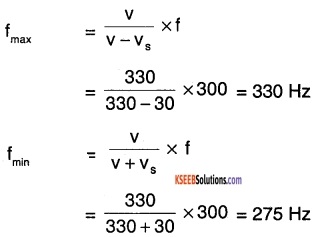
∴ Frequency range = 275 Hz – 330 Hz.
![]()
Question 32.
The wavelengths of 2 notes are 7/165m and 7/167m. Each note produces 5 beats per second with a 3rd note of a fixed frequency. Calculate the velocity of sound in air.
Answer:
Given
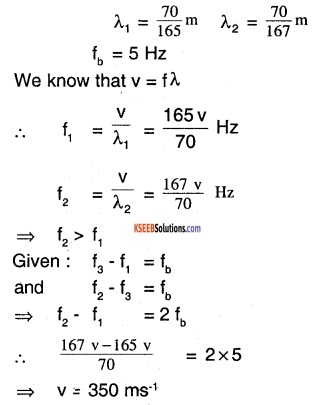
Question 33.
An open pipe is suddenly closed at one end with the result that the frequency of 3rd harmonic of closed pipe is found to be higher by 50 Hz than the fundamental frequency of the open pipe. What is the fundamental frequency of open pipe?
Answer:
Let f0 be the fundamental frequency of the pipe of length l. Then,
\(\mathrm{f}_{0}=\frac{\mathrm{v}}{2 l}\) ………..(1)
Let fe be the 3rd harmonic of closed pipe then,
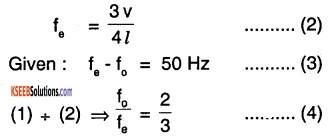
From (3) and (4) we get f0 = 100 Hz
Question 34.
Calculate the number of beats heard per second if there are 3 sources of frequencies (n -1), n and (n +1) Hz of equal intensity sounded together.
Answer:
Let us assume each disturbance has an amplitude ‘A’ then the resultant displacement is given by,
y = A sin 2π(n – 1)t + A sin2πnt+ A sin2π(n + 1)t
i.e. y= 2A sin 2πnt cos2πt + A sin2πnt
y= A(1 + 2cos2πt) sin2πnt
∴ Resultant amplitude: A(1 + 2 cos2πt)
Amplitude is maximum when cos2πt = 1
i.e., when 2πt = 2πk k = 0,1,2……….
i.e., when t = 0, 1, 2, 3……….
∴ Time difference between successive maxima = 1 s
Similarly, amplitude is ‘0’ when cos2πt = -1/2
i.e., when cos2πt = 2πk + 2π/3
k = 0, 1, 2………….
i.e. when t = k + 1/3
i.e., when t = 1/3, 4/3, 7/3 …….
Again the time difference between successive minima = 1 s
∴ The frequency of beats is also 1 Hz.
Thus, one beat is heard per second.
![]()
Question 35.
Two sound waves originating from the same source, travel along different paths in air and then meet at a point. If the source vibrates at a frequency of 2 kHz and one path is 41.5 cm longer than the other, what will be the nature of interference ? The speed of sound in air is 332 m/s
Answer:
We know that v = fλ
\(\therefore \lambda=\frac{v}{f}\)
Given v = 332 ms-1
f = 2 k Hz
⇒ \(\lambda=\frac{332}{2 \times 10^{3}}=0.166 \mathrm{m}\)
We know that phase difference (∆Φ)) and path difference (∆x) are related by
\(\Delta \phi=\frac{2 \pi}{\lambda} \quad \Delta x \Rightarrow \Delta \phi=\frac{2 \pi}{0.166} \times 0.415\)
∴ \(\Delta \phi=5 \pi\)
Since phase difference is an odd multiple ot π, the interference is destructive.
Question 36.
A metallic rod of length 2 m is rigidly clamped at its midpoint. Longitudinal stationary waves are set up in the rod in such a way that there are 2 nodes on either side of the midpoint. The amplitude of an antinode is 4 × 10-6 m. Write an equation of motion of the constituent waves in the rod. (Young’s modulus = 2×1011Nm-2 and density = 8000 kg m-3)
Answer:
General equation of a standing wave is y = 2A sink x cos ωt where
\(\mathrm{k}=\frac{2 \pi}{\pi}\) and \(\omega=2 \pi \mathrm{f}\)
Which is obtained by adding 2 identical progressive waves travelling in opposite directions
i.e., y = y1 + y2 where
y1 = A sin (kx – ωt)
y2 = A sin (kx + ωt)
Let l be the length of the rod: l = 2 m
From the figure below, we see that
\(l=\frac{5 \lambda}{2}\)

We know that velocity of longitudinal wave is given by
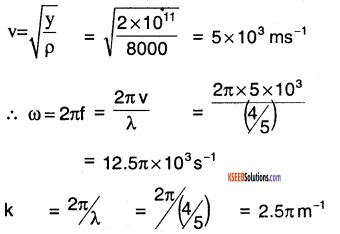
∴ Equation of standing wave :
y = 2(4 × 10-6) sin (2.5 πx) cos (12.5 × 103π) t
Equation of constituent waves
y1 = (4 ×10-6) sin (2.5πx – 12.5 × 103 πt)
y2= (4 × 10-6) sin (2.57πx + 12.5 × 103 πt)
